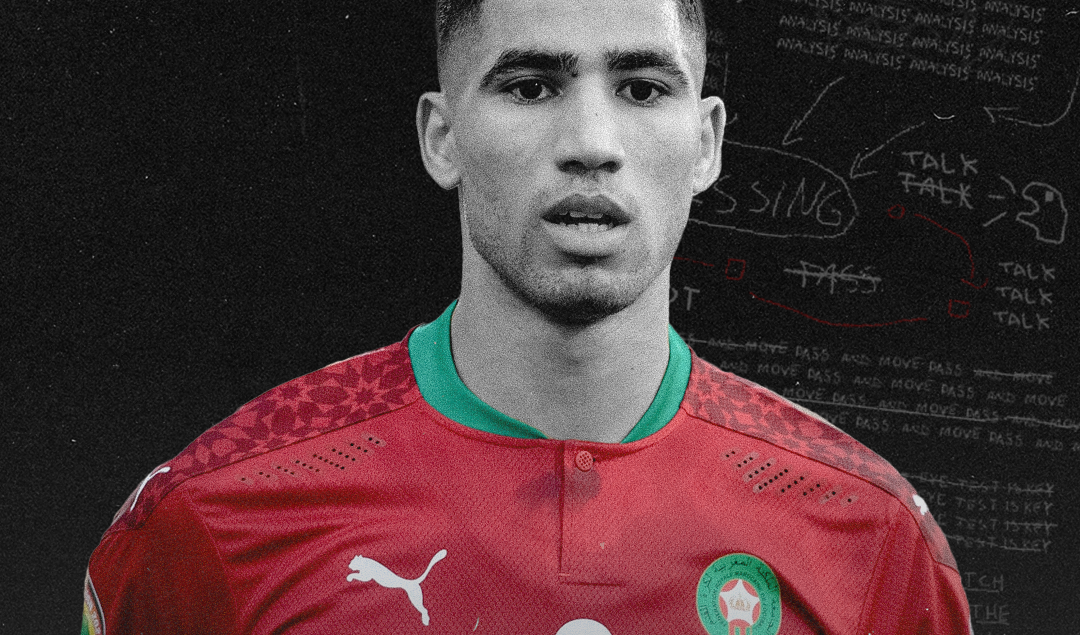How Morocco Shocked Portugal and Became the First African Team to Reach the World Cup Semifinals
Morocco have pulled off history by becoming the first African team to reach the World Cup semifinals, having conceded just one goal — an own goal from center back Nayef Aguerd against Canada — in their first 5 matches across 480 minutes. Whilst they would go on to lose 2-0 to France in the semis and 2-1 to Croatia in the third-place match, their 2022 World Cup campaign will live on for eternity.
Despite missing two key defenders in Noussair Mazraoui and Aguerd, despite being forced to sub off captain Romain Saïss due to injury in the 57th minute, and despite playing the final six minutes with 10 men, Morocco shocked the world by defeating Portugal 1-0 in the quarterfinals. Walid Regragui went with his usual 4-3-3 shape that turned into a 4-1-4-1 in a mid-block and that shifted into a 5-4-1 in a low block, whilst Fernando Santos opted for a 4-3-3 formation with only one change from the previous match: Ruben Neves for William Carvalho.
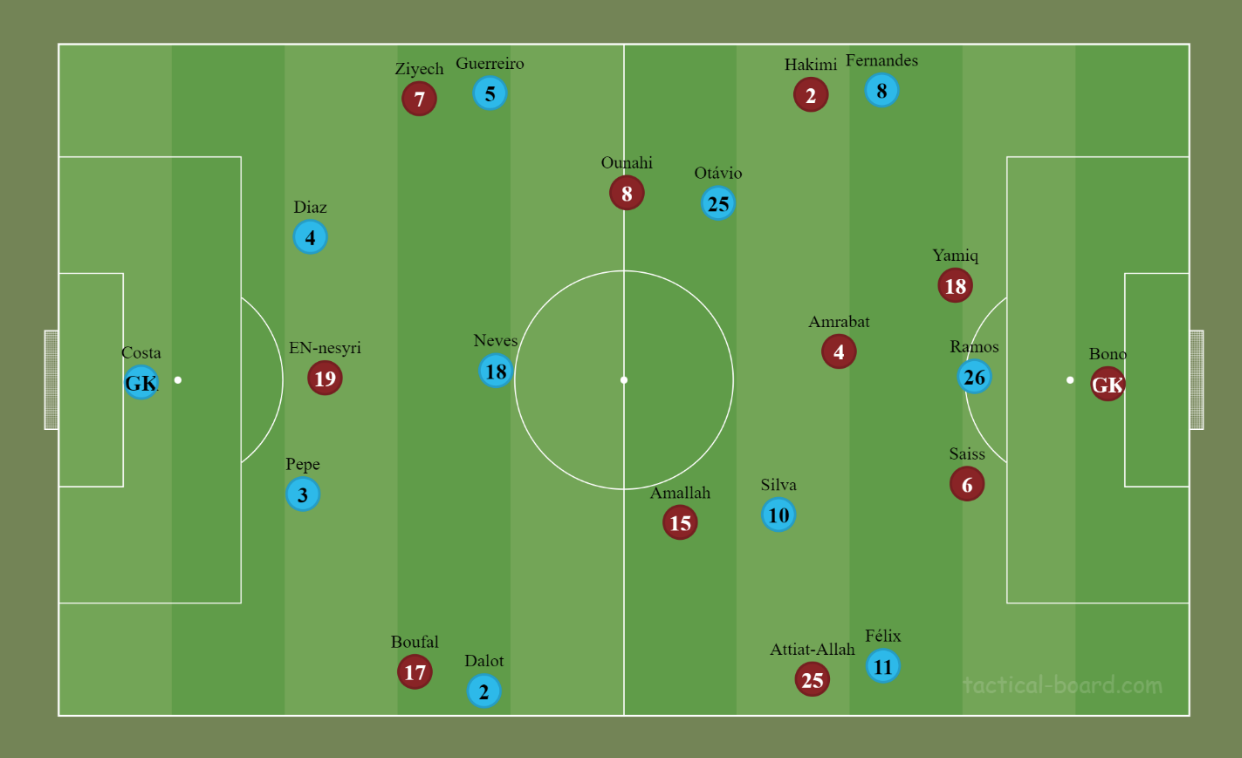
Morocco’s Build-up Play
Unlike the previous matches, Morocco tried to build up from the back and gain more possession with the fullbacks close to the center backs and Sofyan Amrabat positioning himself in front of them, and the involvement of goalkeeper Yassine Bounou (Bono) in the process of rotating the ball.
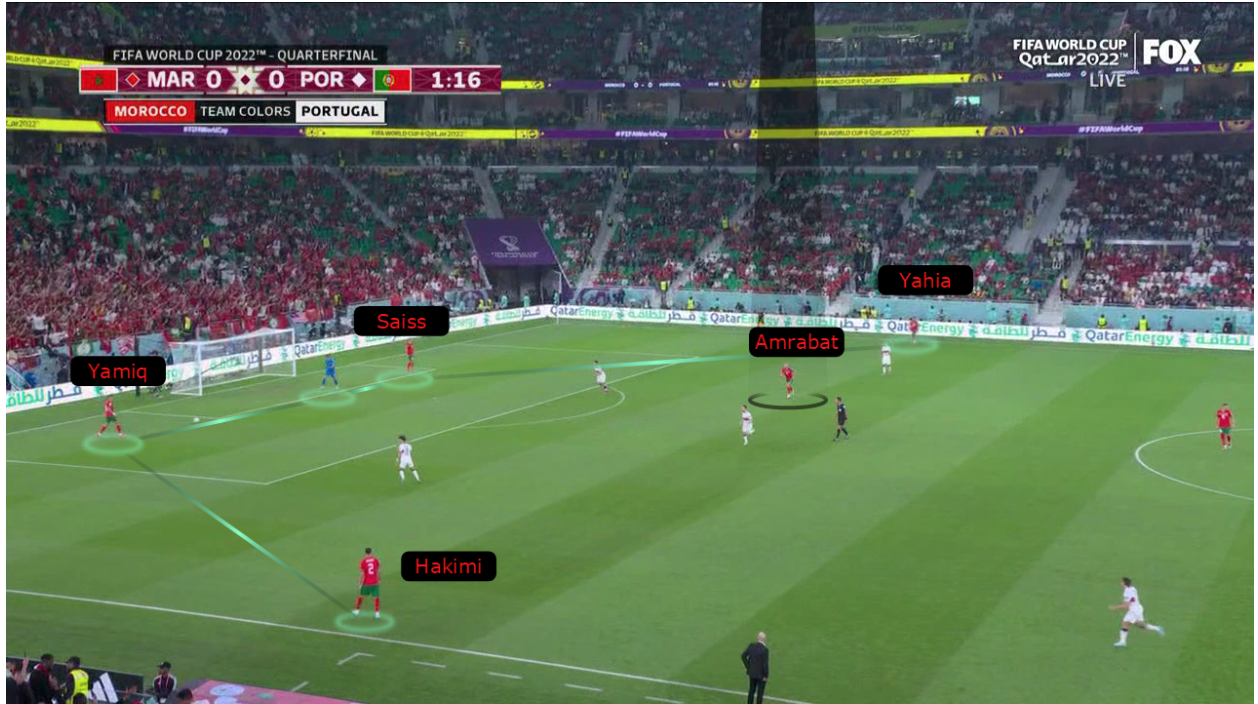
On the other hand, Portugal was pressing high, almost in the shape of a 4-2-3-1, with Gonçalo Ramos in the first line of the press to mark the GK and the left CB, while João Félix pressed the right-sided CB if the ball arrived. When the ball reached Achraf Hakimi, Raphaël Guerreiro would come out to put pressure on him.
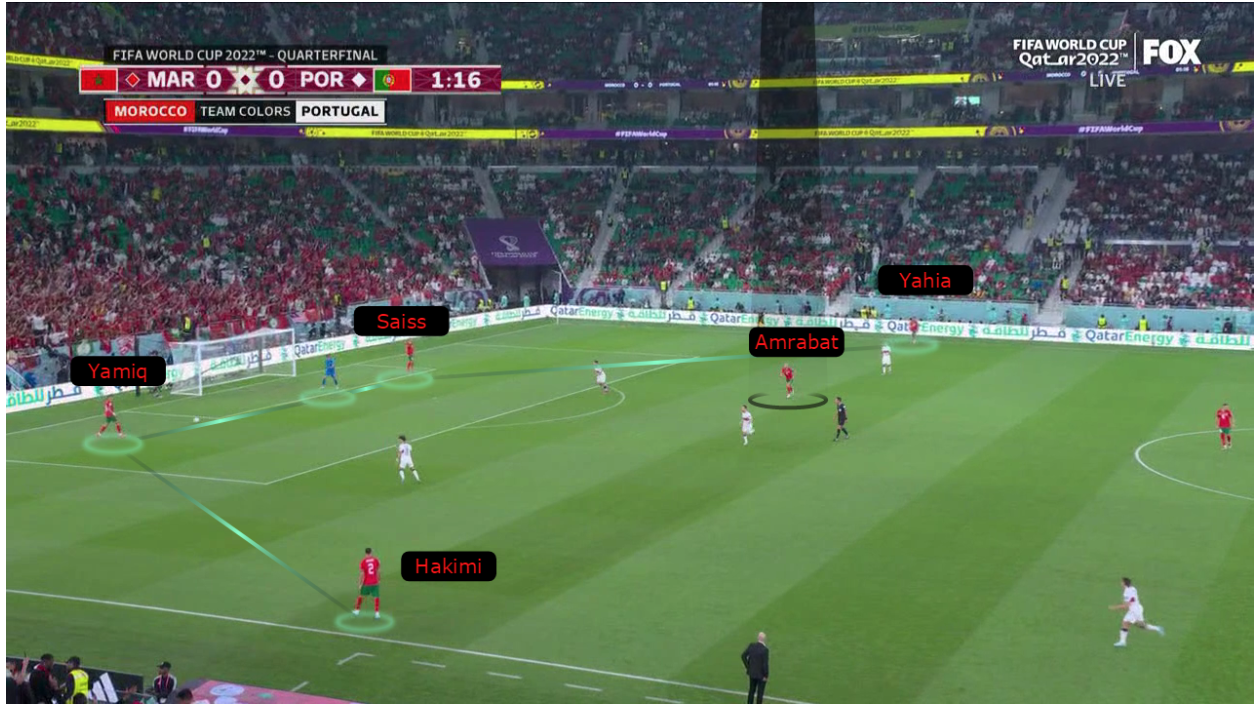
With the accelerated pressure on the GK and the lack of passing options, Azzedine Ounahi falls back to receive the ball and break the pressure of Portugal, but Otávio continues to mark him and prevents him from receiving the ball, so the ball carrier is forced to play the high pass forward that was cut by the Portuguese defenders because of the 4v2 numerical superiority.
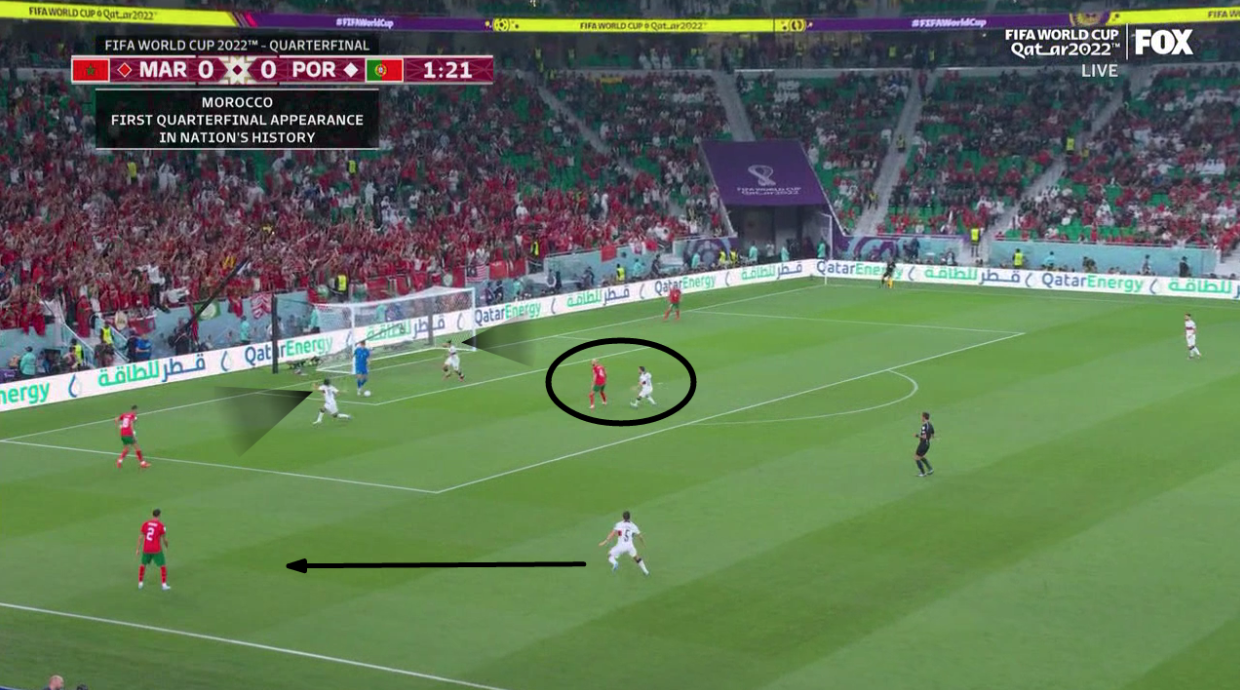
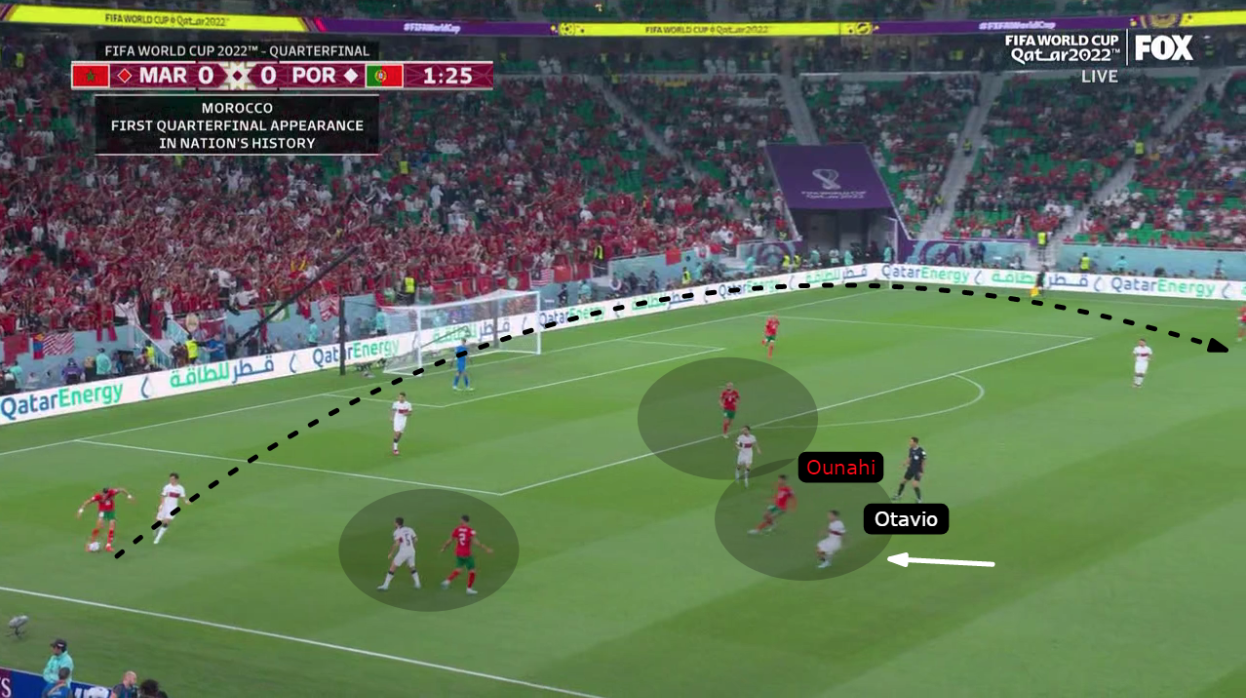
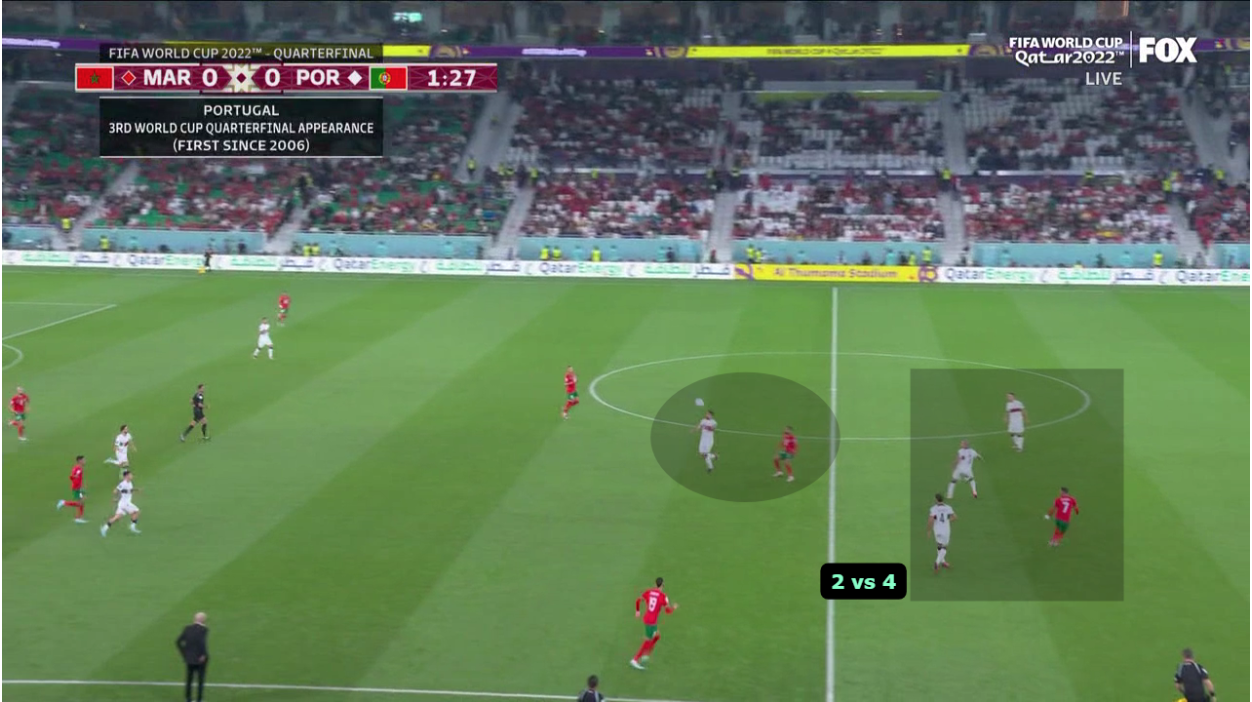
Morocco expands the field to create a space in the depth for Ounahi to fall back next to Amrabat to create a 2 vs 1 situation in a deep area. Neves dropped to mark him, but he left space behind him, allowing Bono to play the long pass to Youssef En-Nesyri and exploit the vacant space.
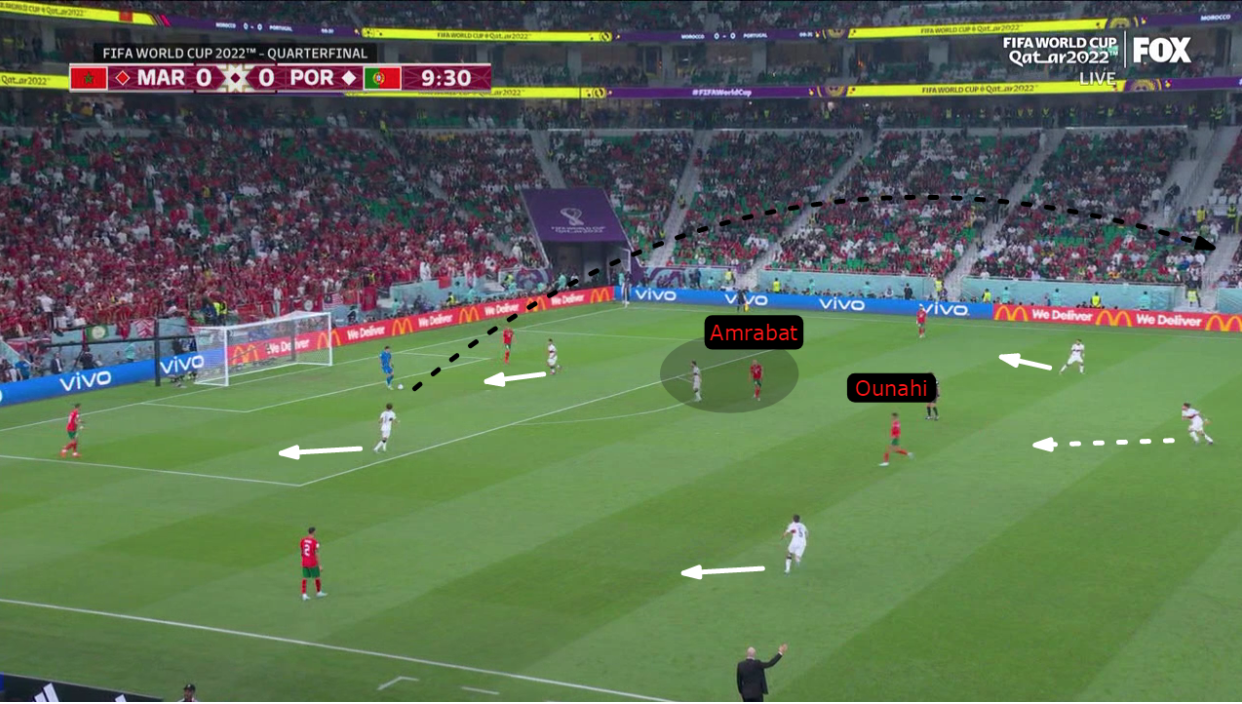
Morocco started overloading on Hakimi’s side, with Hakim Ziyech, Amrabat, and Ounahi close to him, and the ball began to come out from there and the play was shifting to the other side through Amrabat to exploit Portugal’s shifting to the ball area. However, Fernando Santos quickly solved this problem by creating overloads on the same side, with Neves and Silva on the same side as Guerreiro, and the ball was returning to the CBs again.
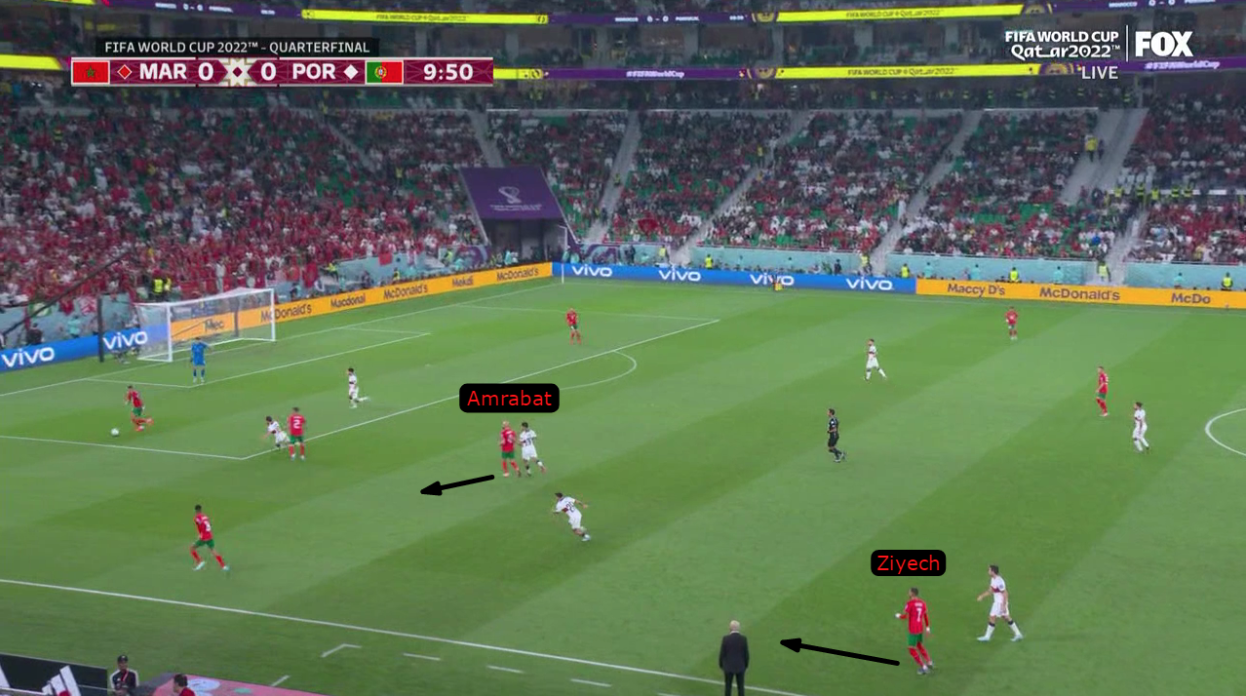
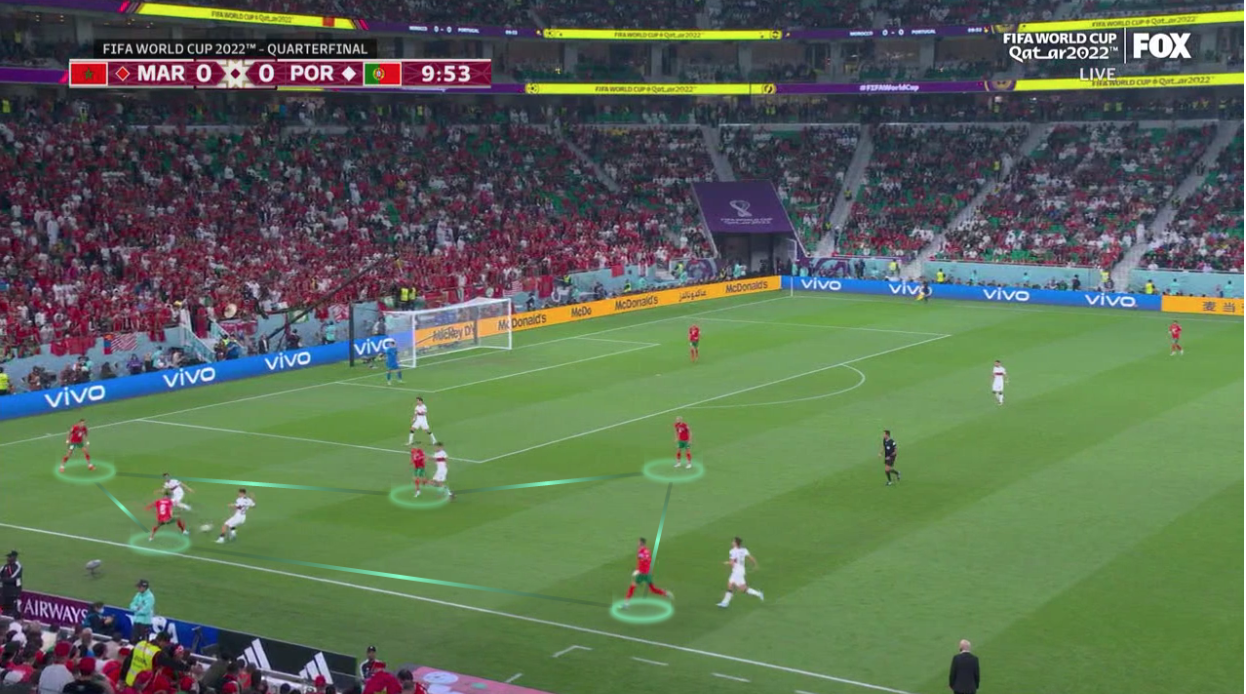
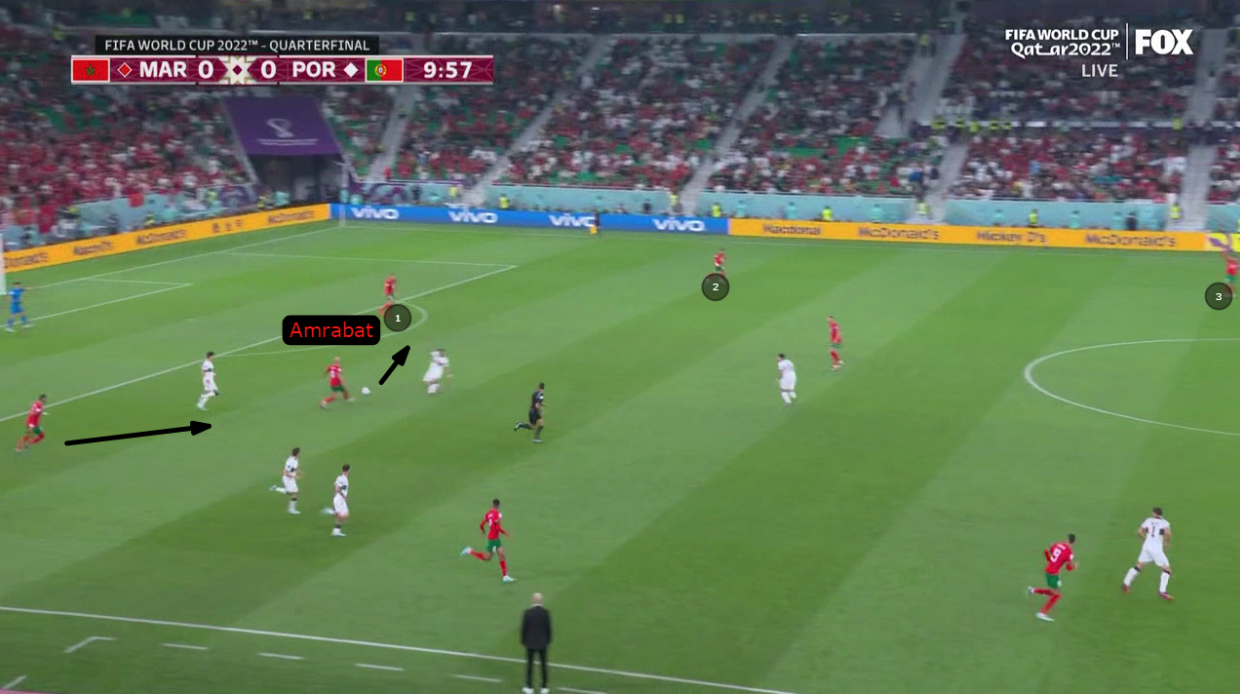
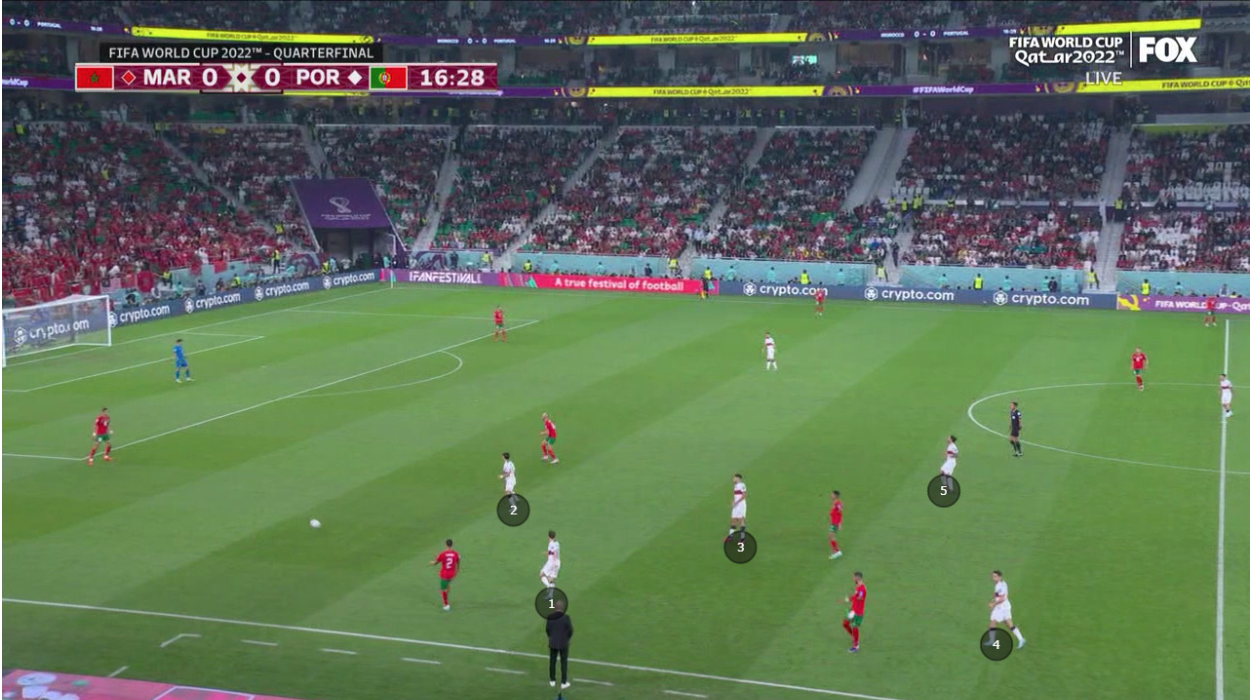
Bono would often play long balls towards En-Nesyri who was often able to win the aerial duel or deflect it and allow a teammate to win the second ball, although Pepe and Rúben Dias did well to limit the success of Morocco’s direct style of play.
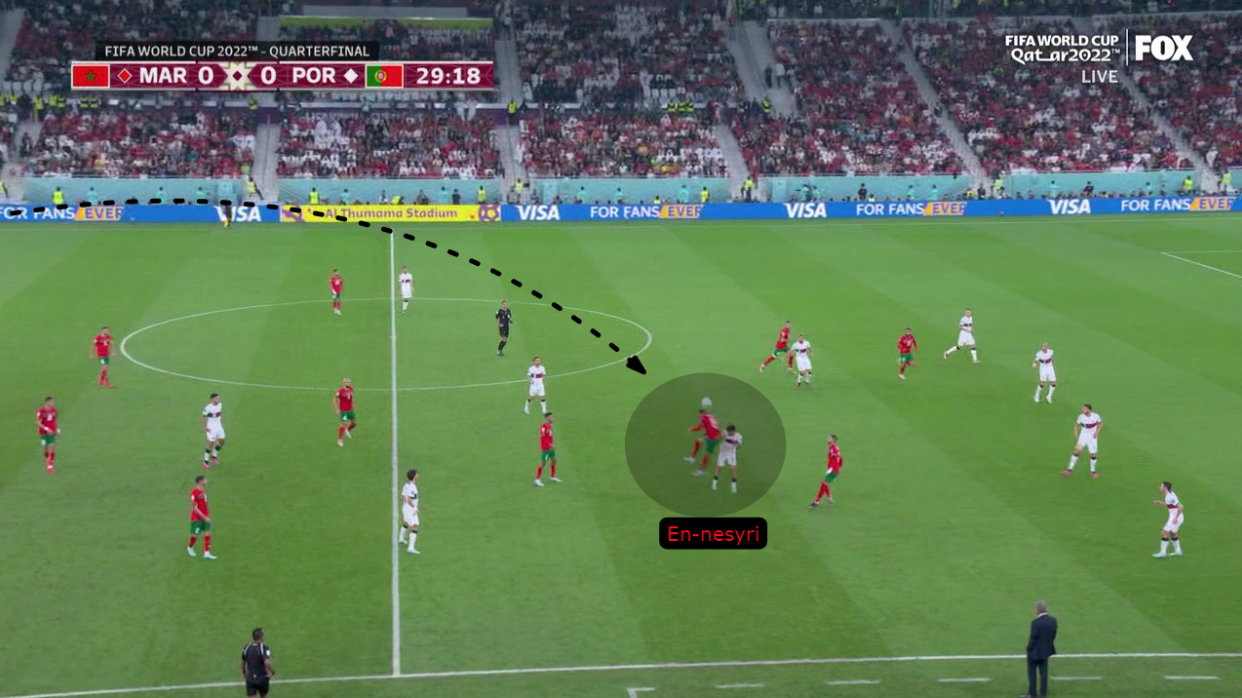
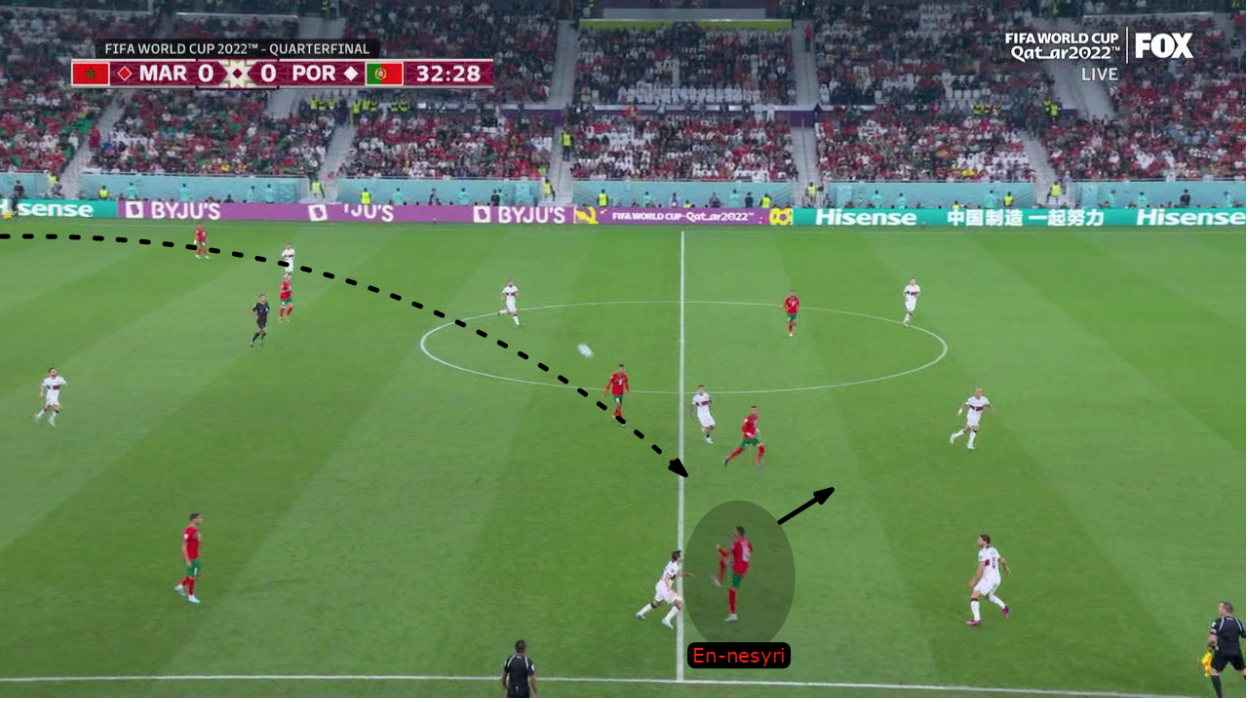
Morocco took the lead in the 42nd minute as Amrabat dropped between the two CBs to create a 4v3 situation and create space for Ziyech and Ounahi to move and receive the ball, and this is what happened when Ounahi received deep and broke the two lines of press, and then by linking with Ziyech the play was shifting to the side of Boufal who received in space.
Seven Moroccan players began to flood the final third with En-Nesyri moving from the defenders’ blind side and into the box, finding himself outside of the field of vision of both Dias and Pepe. With Selim Amallah moving into the half-space to attract the attention of Dias, Yahia Attiyat Allah delivered a pinpoint cross to En-Nesyri who jumped over Dias and fired in a header to open the scoring.
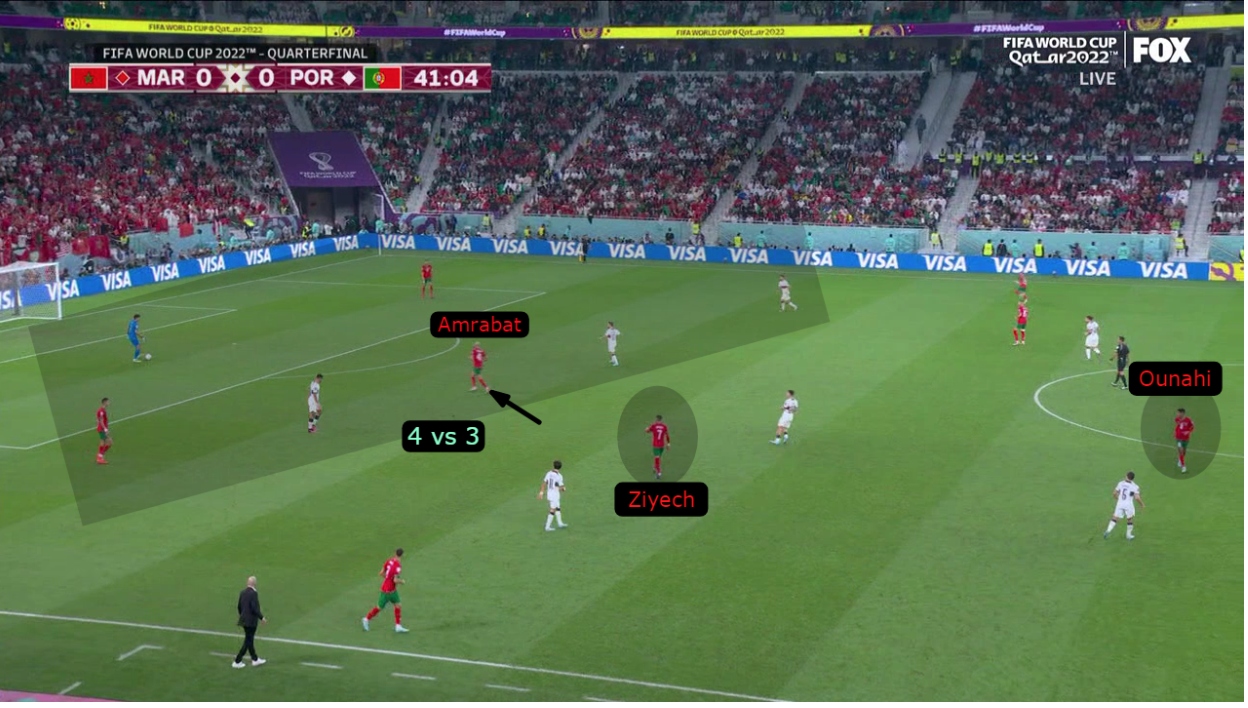
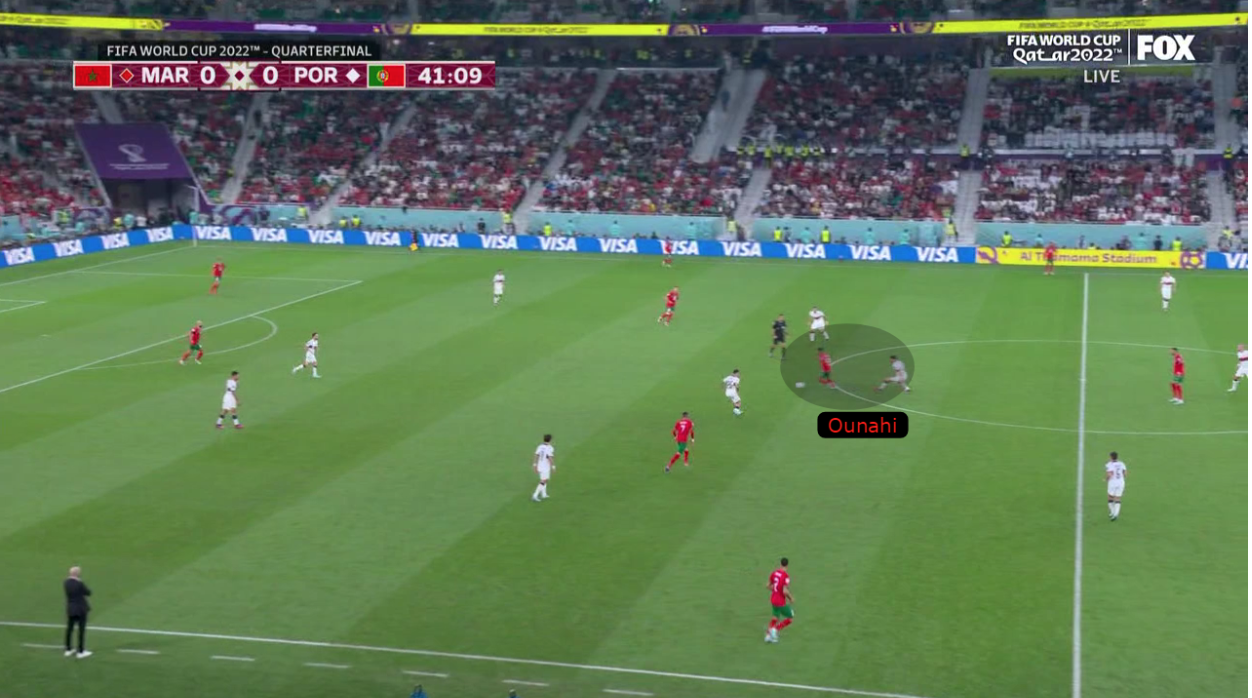
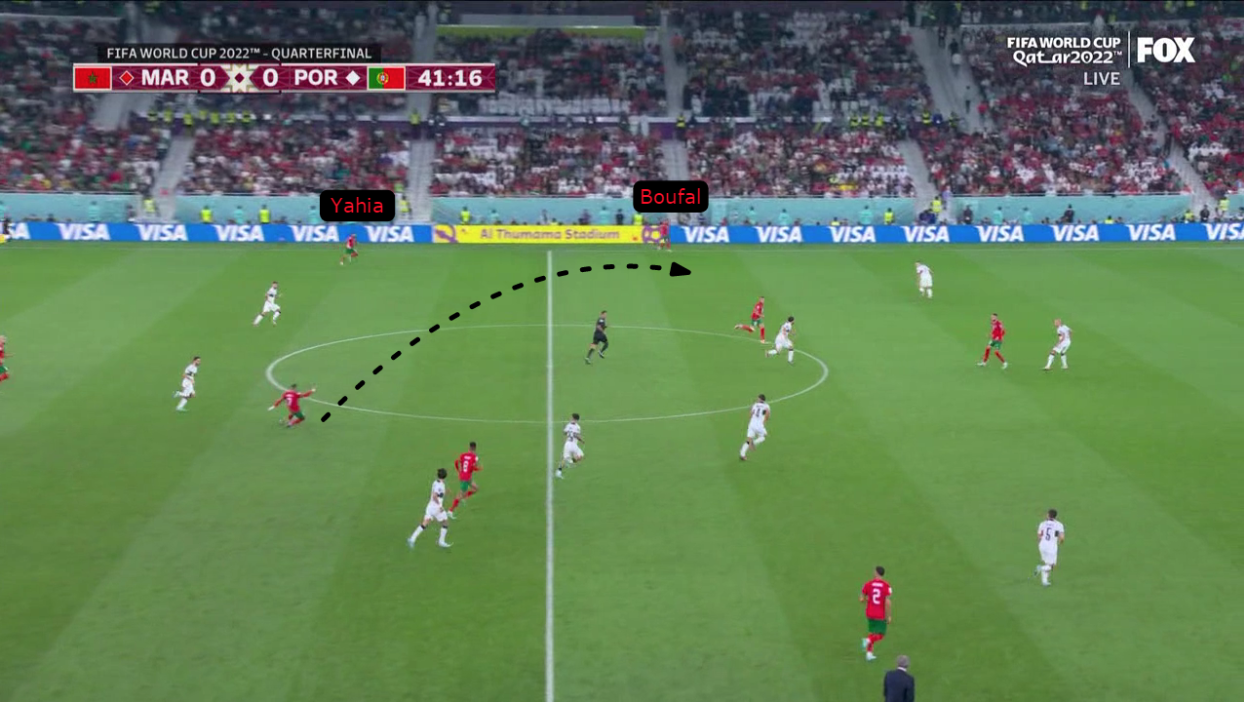
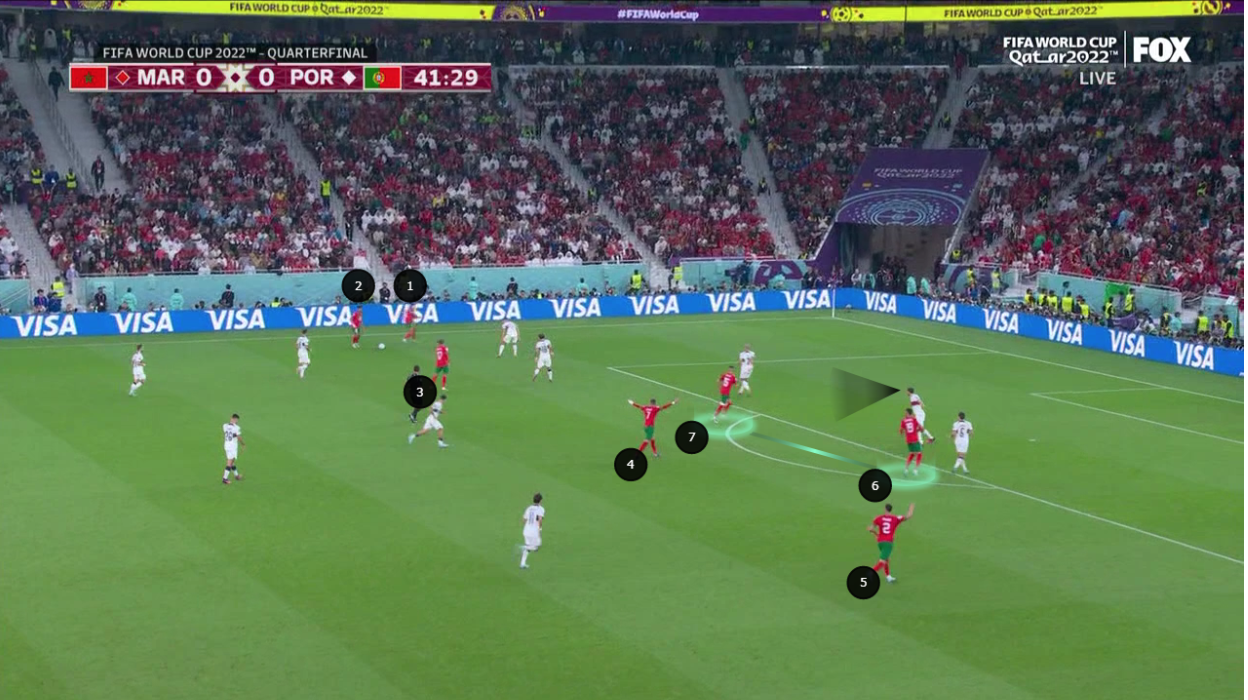
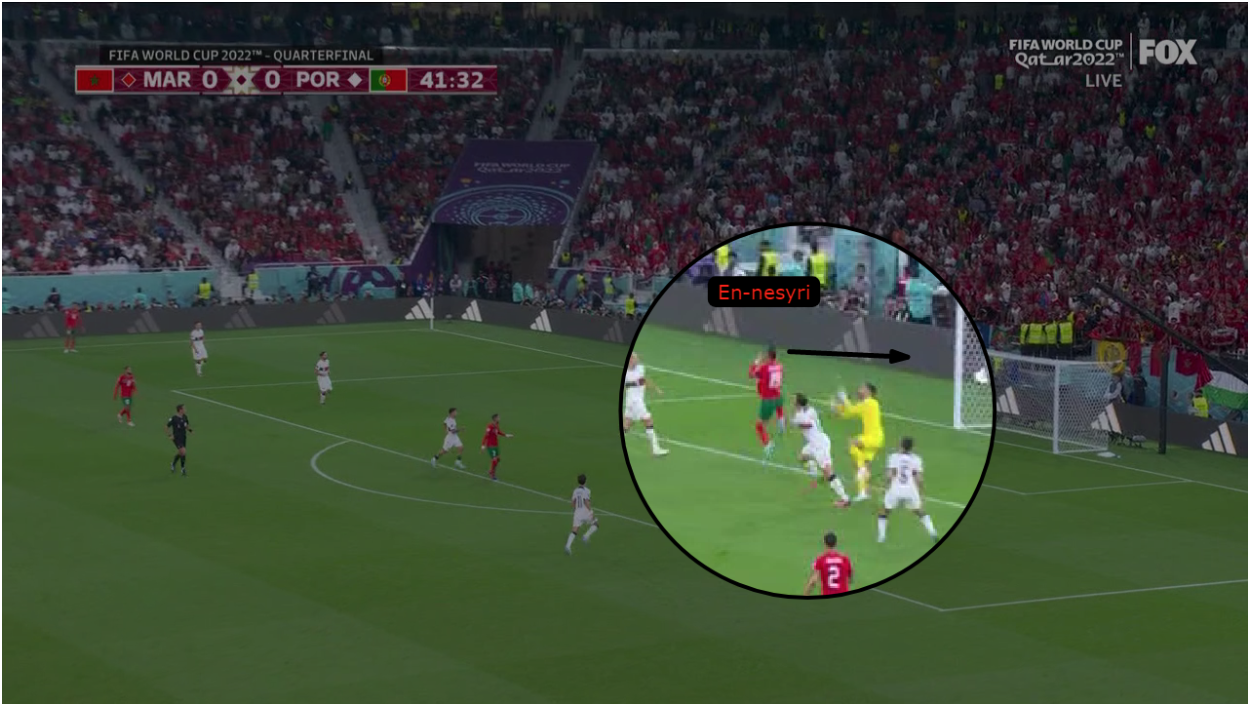
Morocco’s Mid-block Phase
Portugal’s full-backs, Diogo Dalot and Guerreiro, were pushed to the top with the dropping movement of one of the midfielders, usually Neves, or the fall of another player with him, Bernardo Silva or Otávio, next to the CBs Dias and Pepe, with more free movements for Félix between the lines with Silva to create a situation of numerical superiority over Amrabat, and the full-backs would push forward to try to produce width and stretch the Moroccan lines to find space between the lines and halve the space.
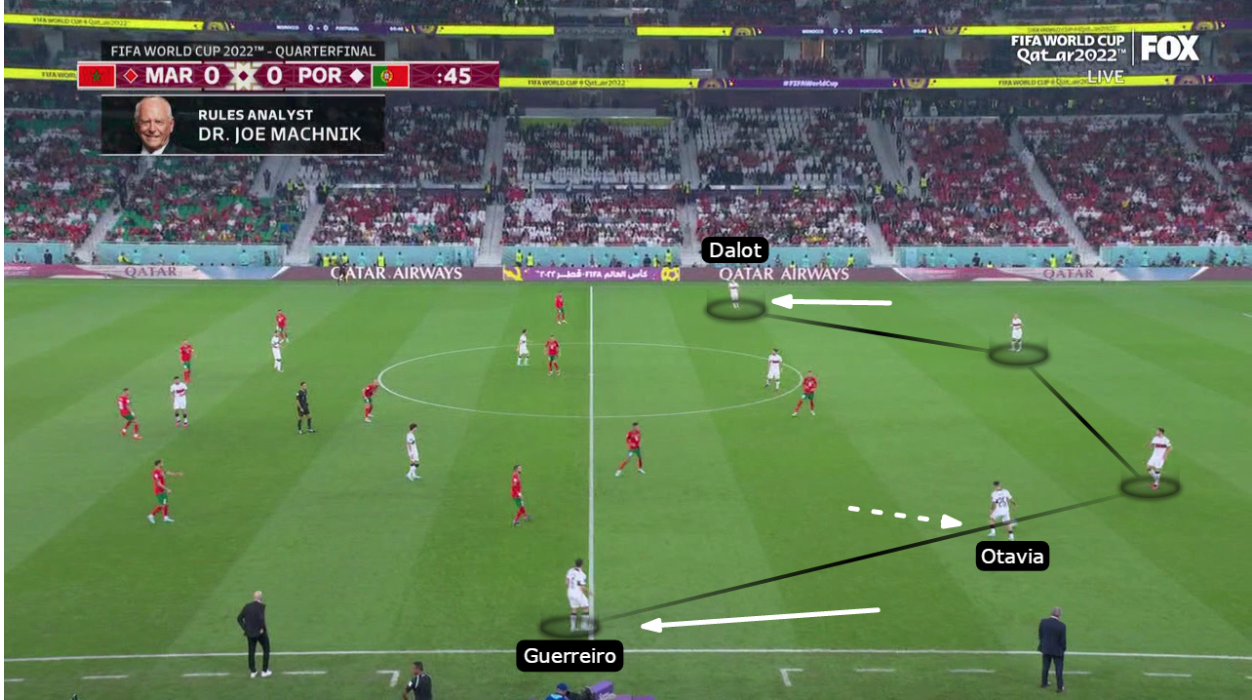
The usual 4-1-4-1 for Morocco, with En-Nesyri in the first line of pressure to close the space in front of the pivot player — Neves or Silva — whilst cutting the passing channel from the two CBs. Ounahi and Amallah would cut the passing channel towards half the space, Ziyech and Sofiane Boufal marked Dalot and Guerreiro, and Amrabat stayed in front of the CBs with freedom of movement towards the ball area in the defensive phase to create numerical superiority.
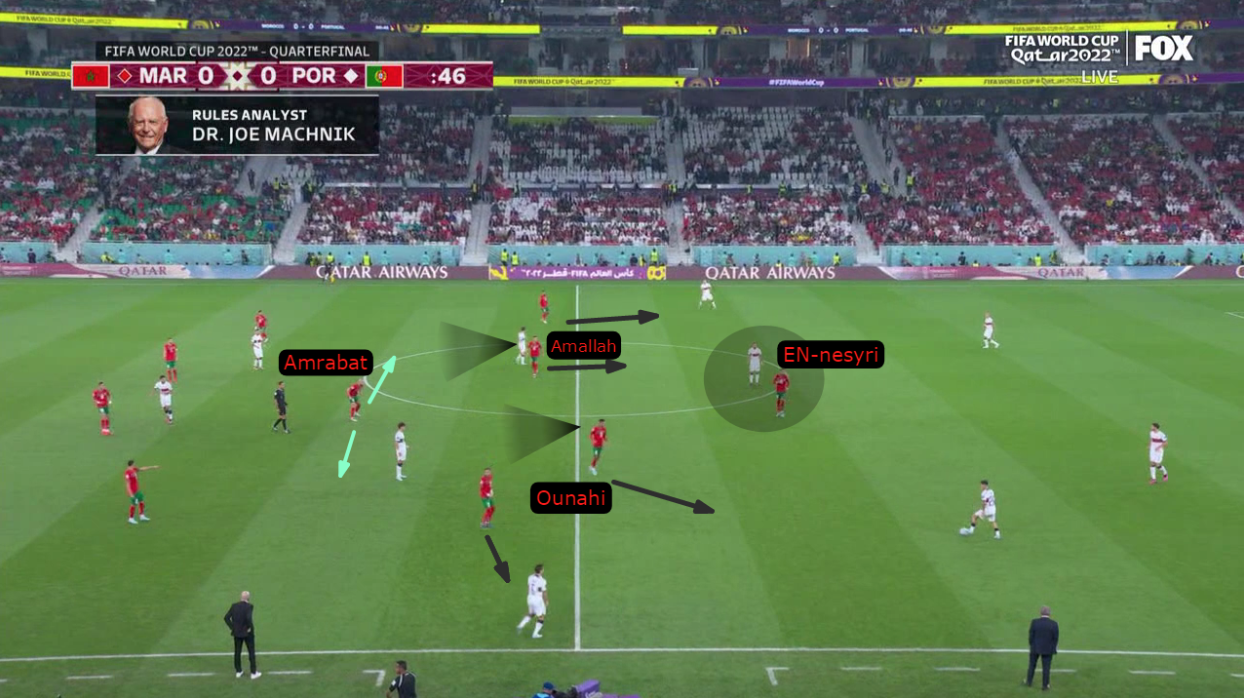
When the ball arrived onto the flank, Portugal tried to attack from the wide area with the closing of the depth from Morocco. Amrabat and Ounahi were in a defensive role with Ziyech and Hakimi with the overload, closing the passing options and forcing the ball to go back to a safer area.
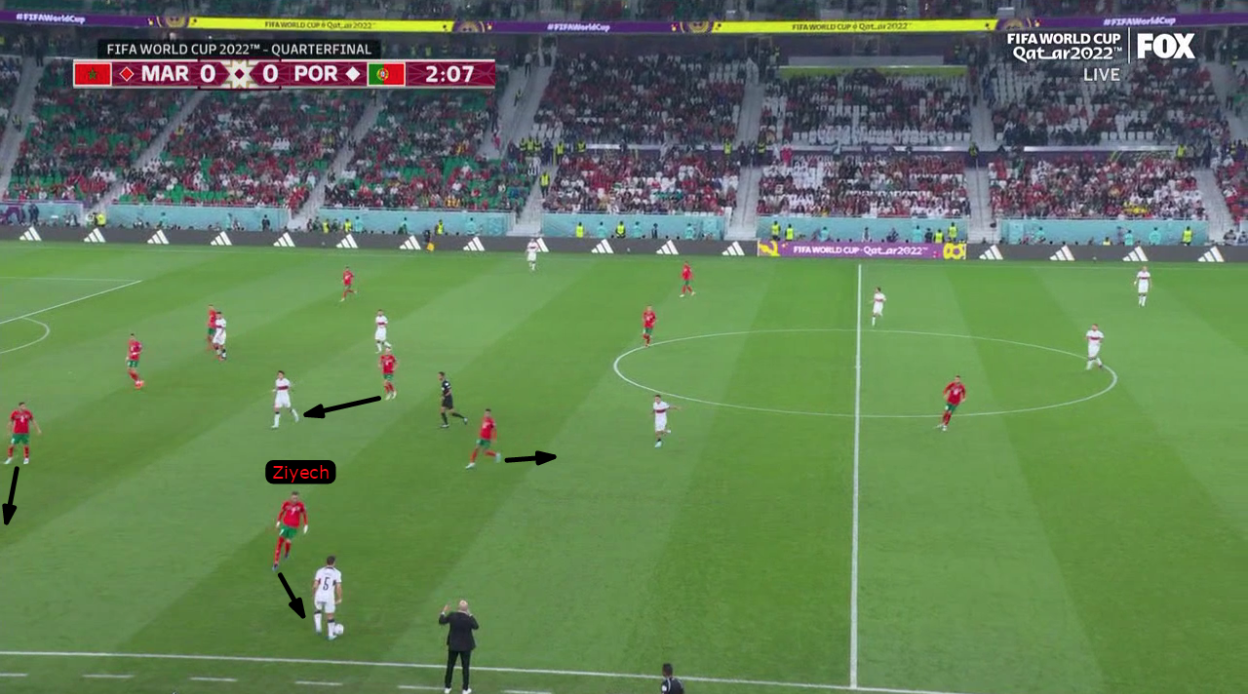
Silva seemed to drop with Neves in the back to try to get the ball out of Morocco’s block, and he succeeded in breaking the first stages of the press, but at the same time this caused a problem in the front because there were no passing options in the front, and it made it easy for Morocco to defend since at least five players from Portugal are behind the ball.
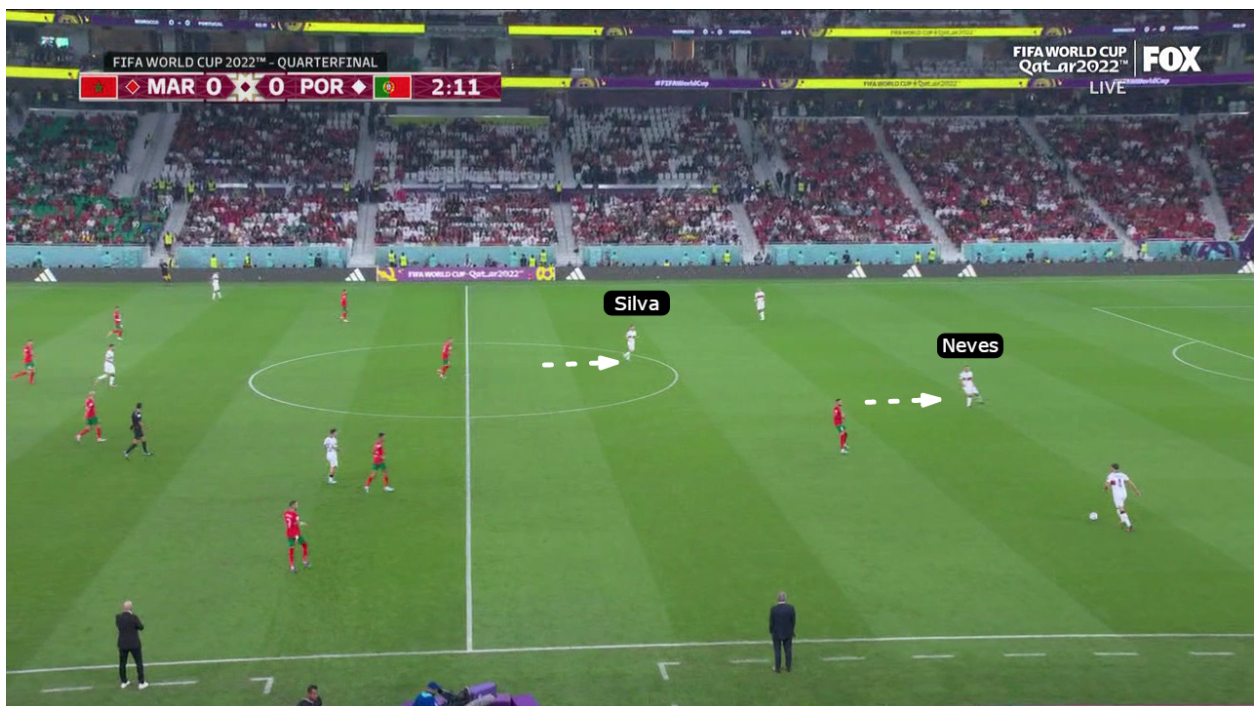
As such, Portugal’s center backs would play long or diagonal passes toward the flank to take advantage of the Moroccan players’ deep positioning after being stretched with the player on each side of the field to exploit the space there, but many Portuguese players were behind the ball, which creates the numerical superiority in front of the Moroccan players.
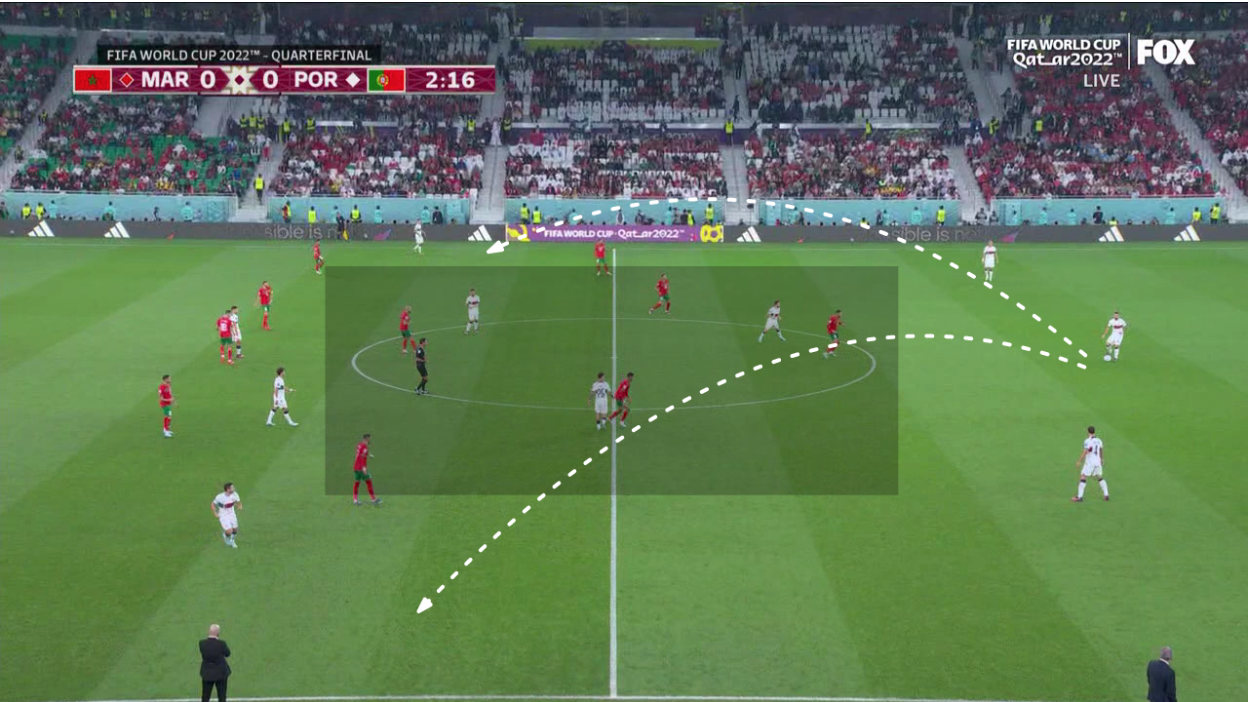
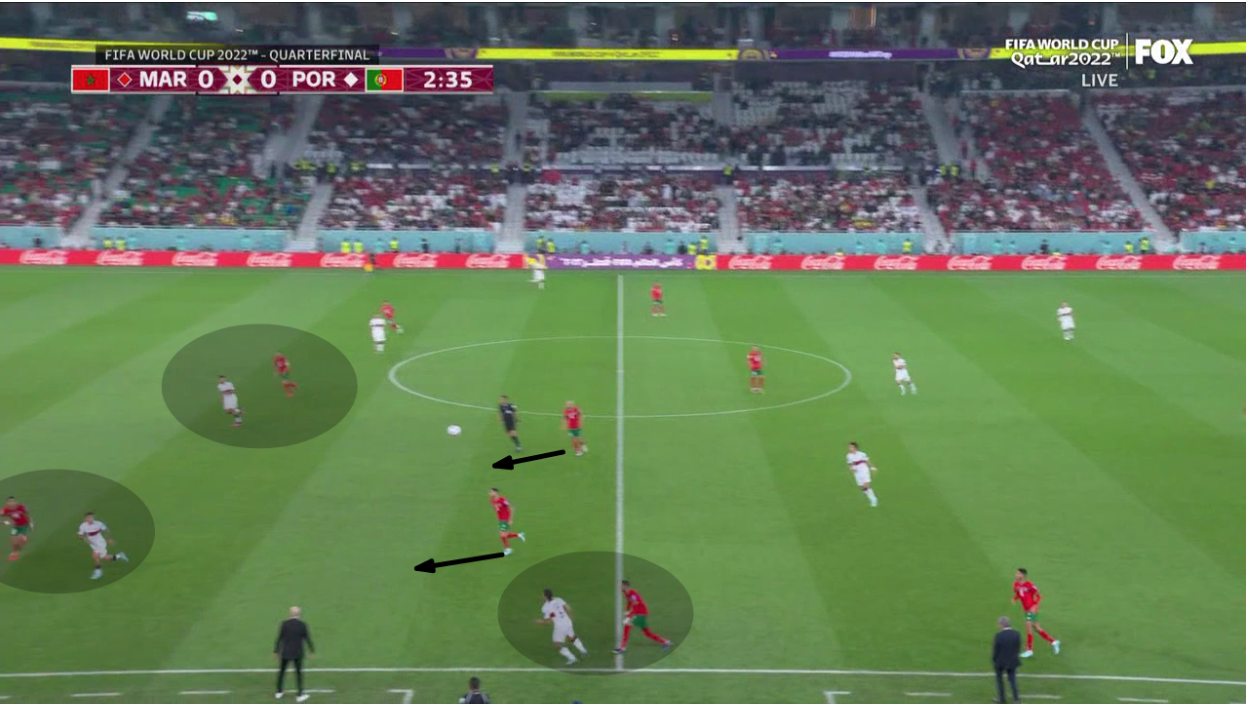
After that, Portugal started to find a solution with the expansion and stretching of Morocco’s lines of press by finding free spaces in the half-spaces in which Bruno Fernandes or Félix was moving on the other side or finding ample space on the flank in which Guerreiro, Dalot or Félix could move to receive the long or diagonal pass behind the Moroccan defenders.
Regragui would find a solution by having Ziyech mark whoever is in the full-back position, who could be the midfielder Otávio, and Hakimi to press the winger, Amrabat closing down the space, and leaving space in the back space for the two CBs to deal with them and move faster to the ball area.
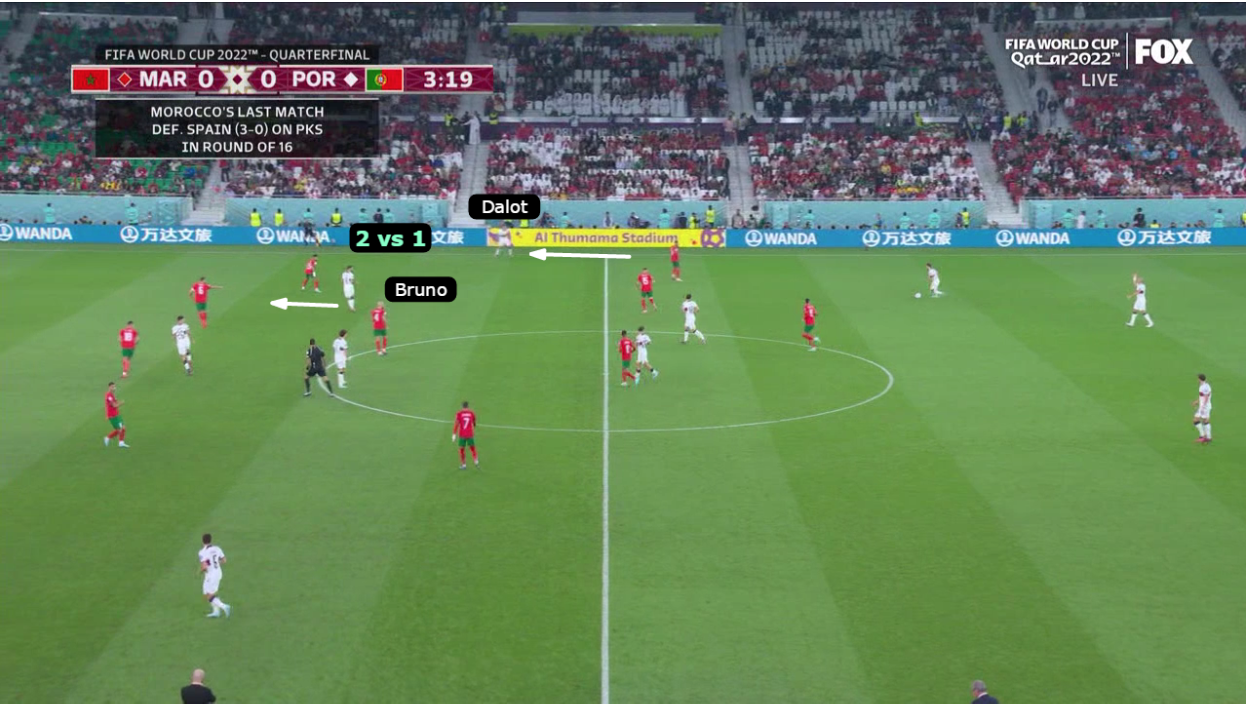
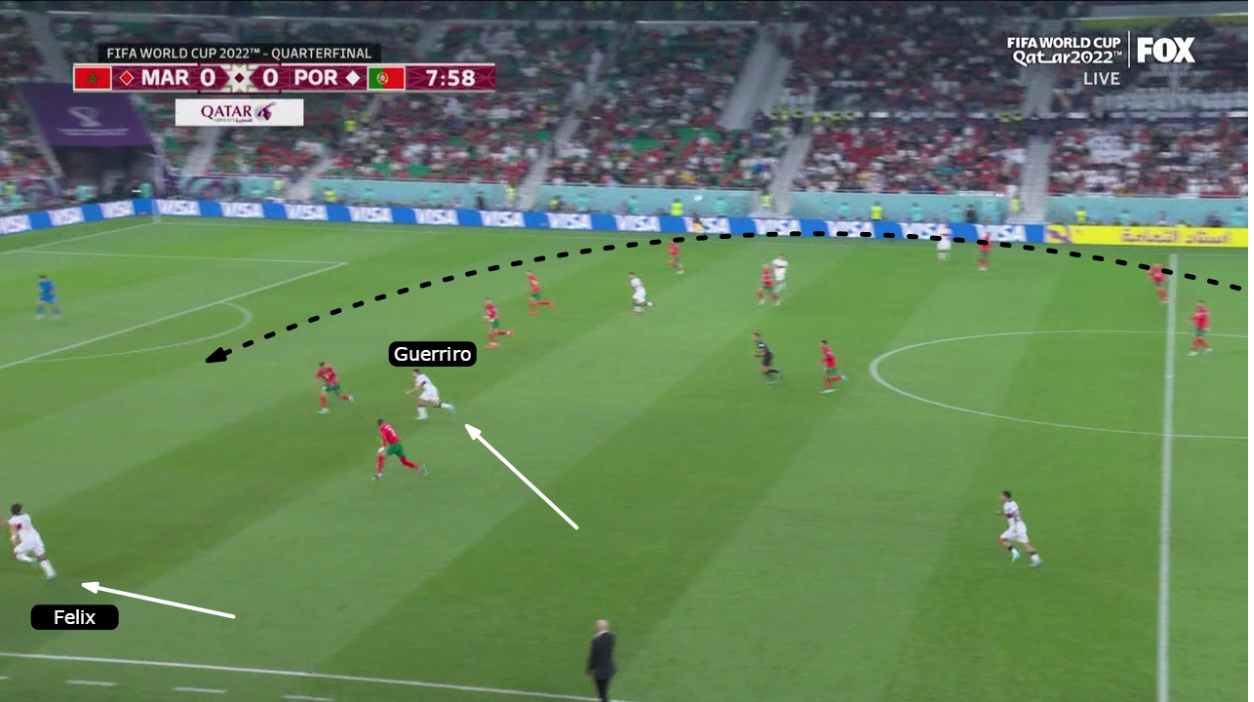
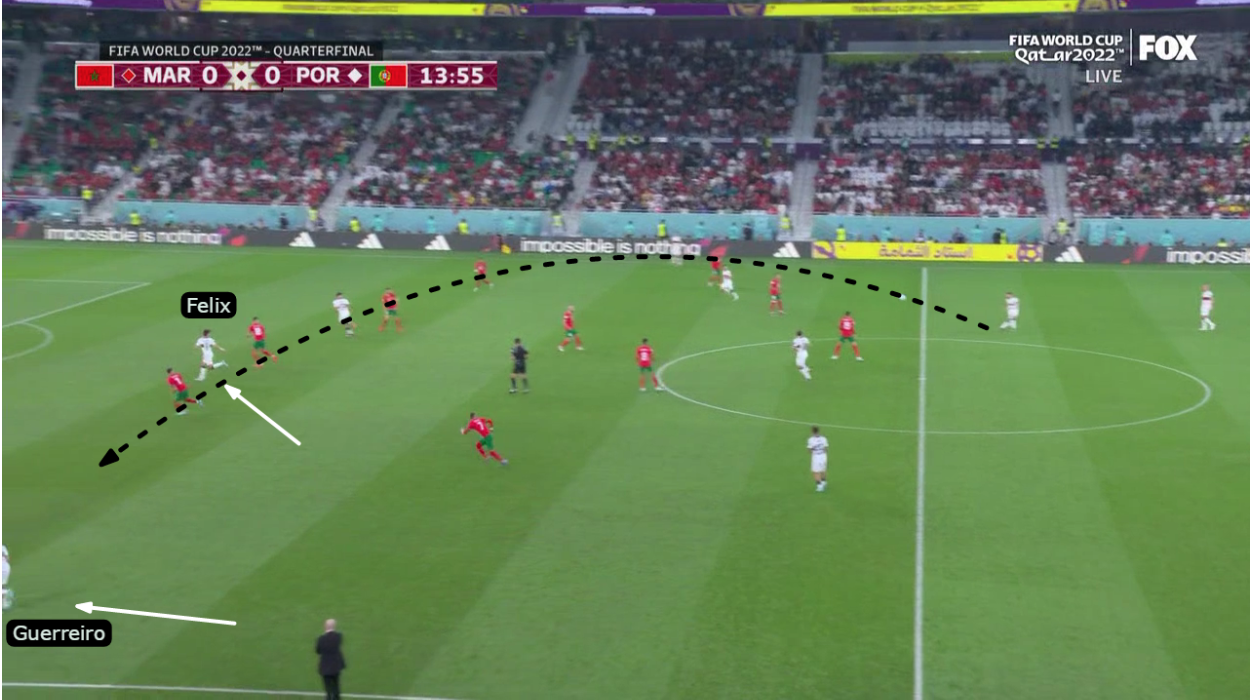
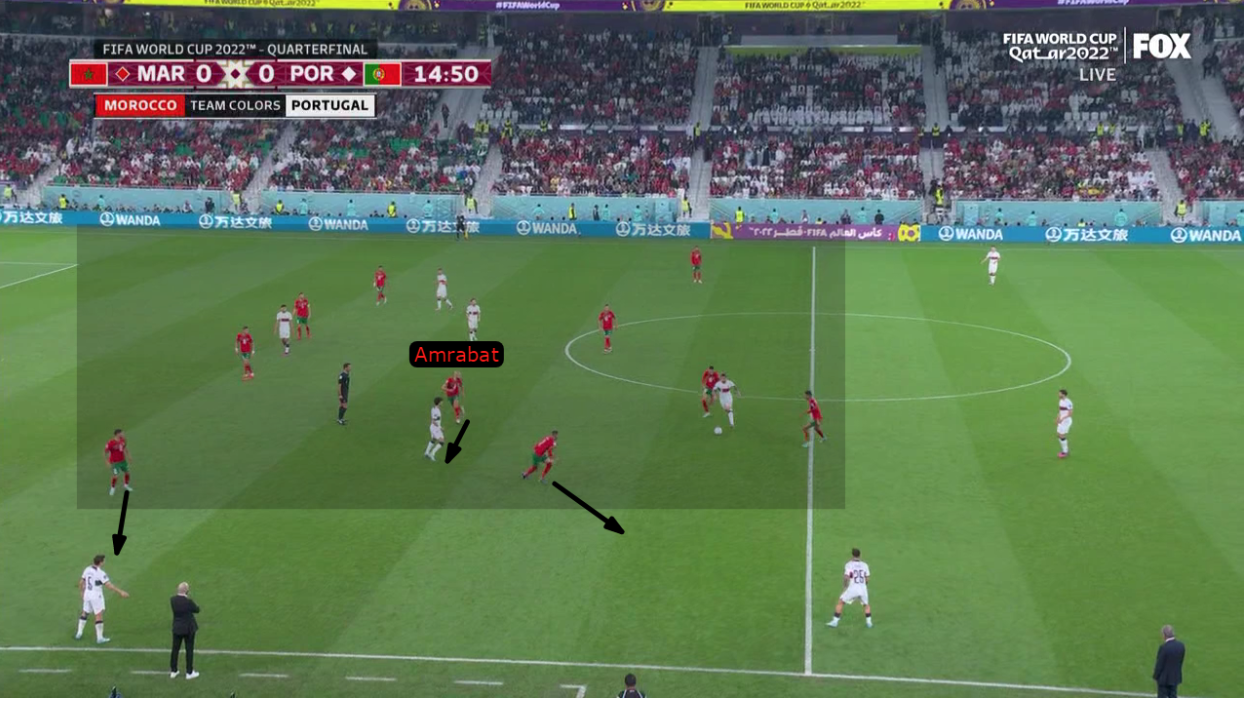
With Portugal having ample players deep, this reduced their passing options in midfield or in the final third, which caused problems in grading and linking with the ball, so the ball carrier had only one option by sending the long pass to Félix on the side, but Hakimi dealt with him well in the 1 vs 1 defensive action.
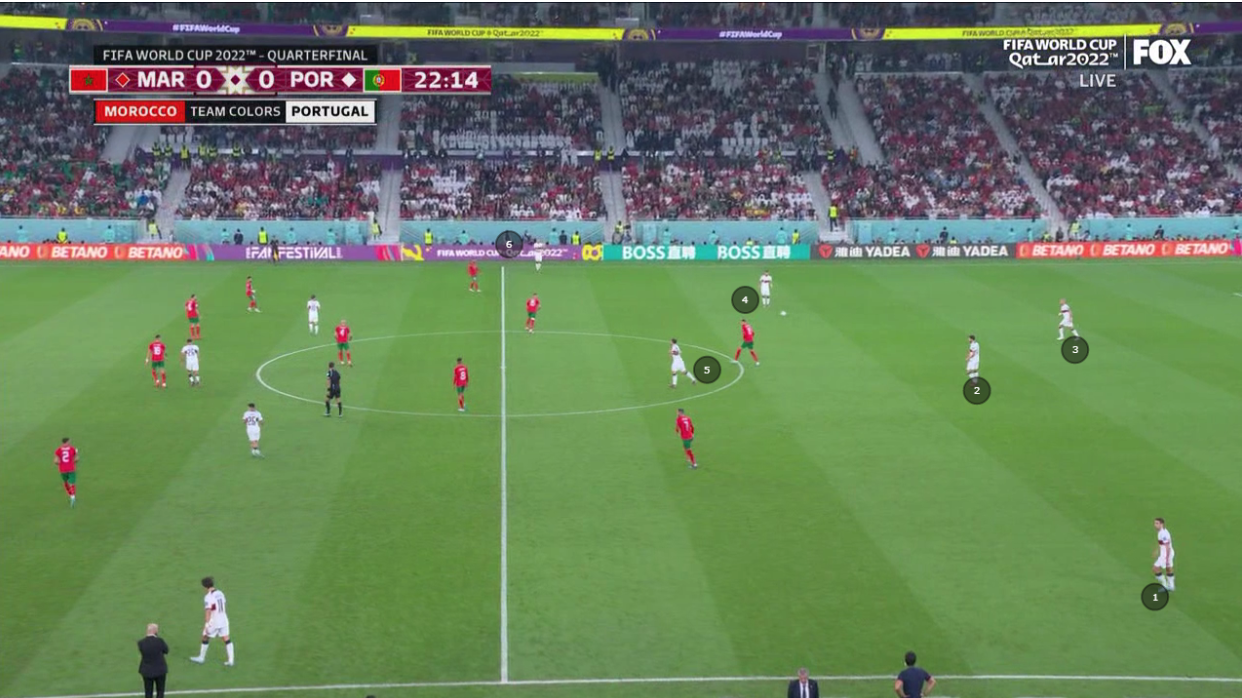
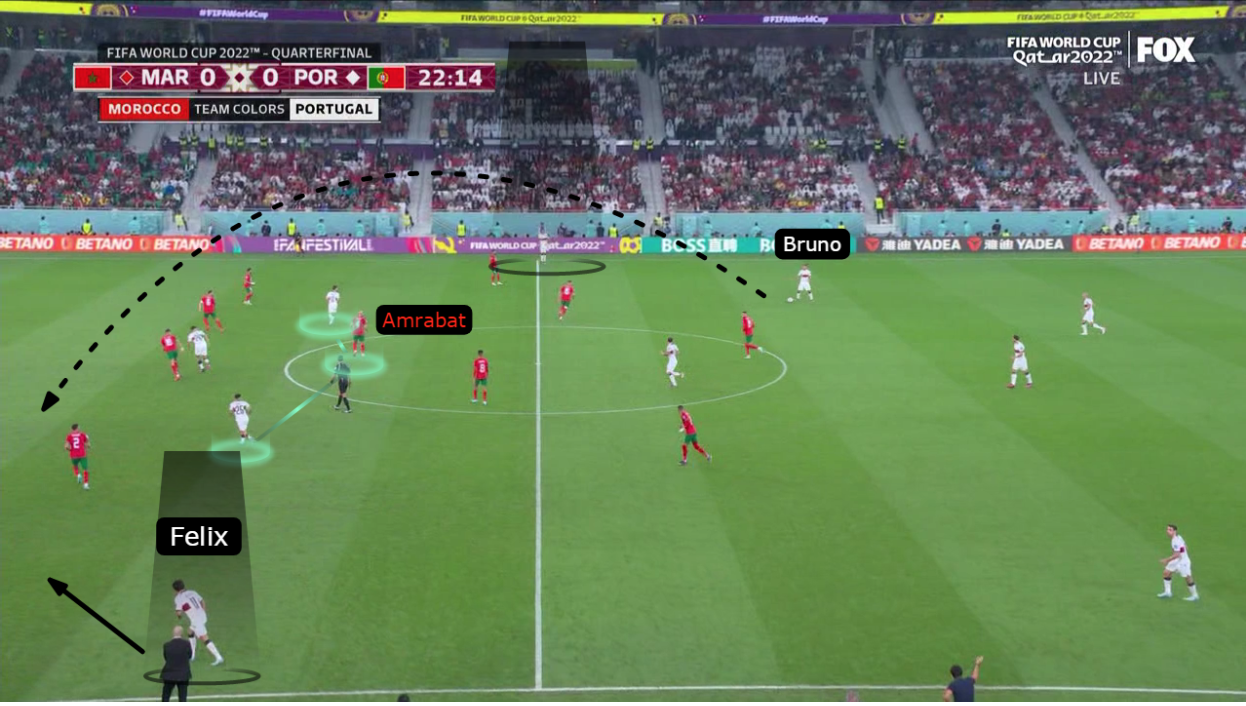
Portugal tried to pull the Moroccan players to high areas to pass the ball in the space behind them by pulling Guerreiro to Ziyech and Felix to Hakimi, but the solution was always at Amrabat by covering the space in depth and the half-spaces.
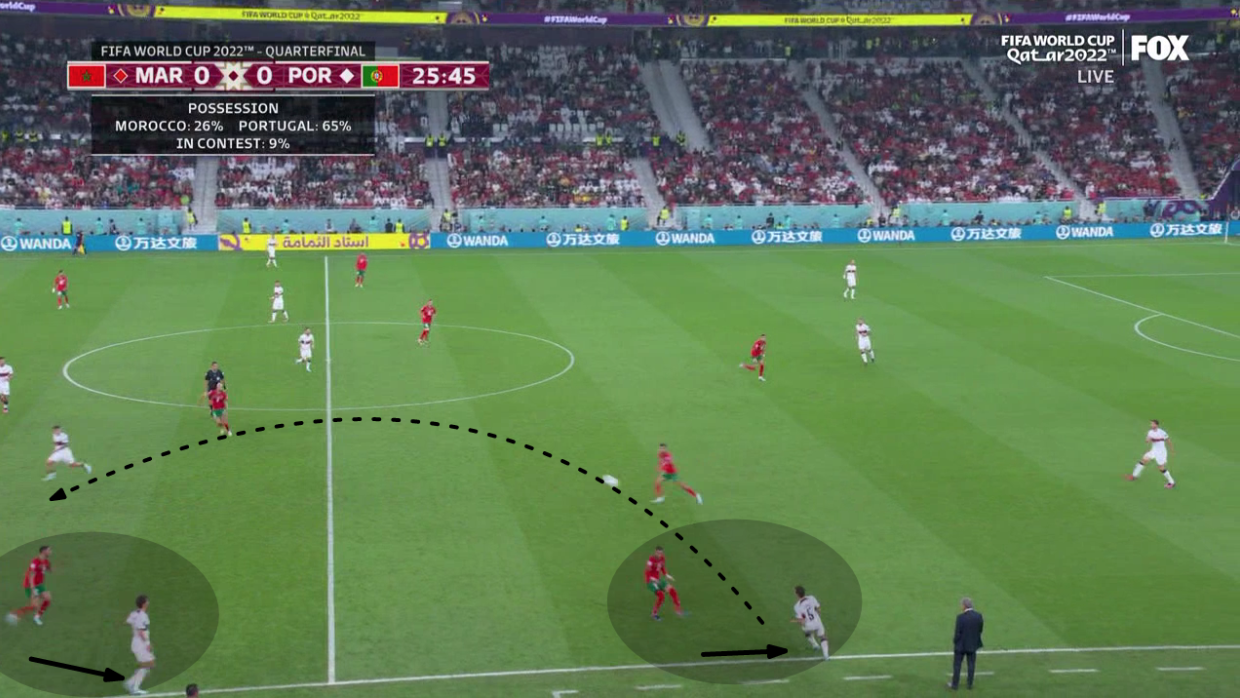
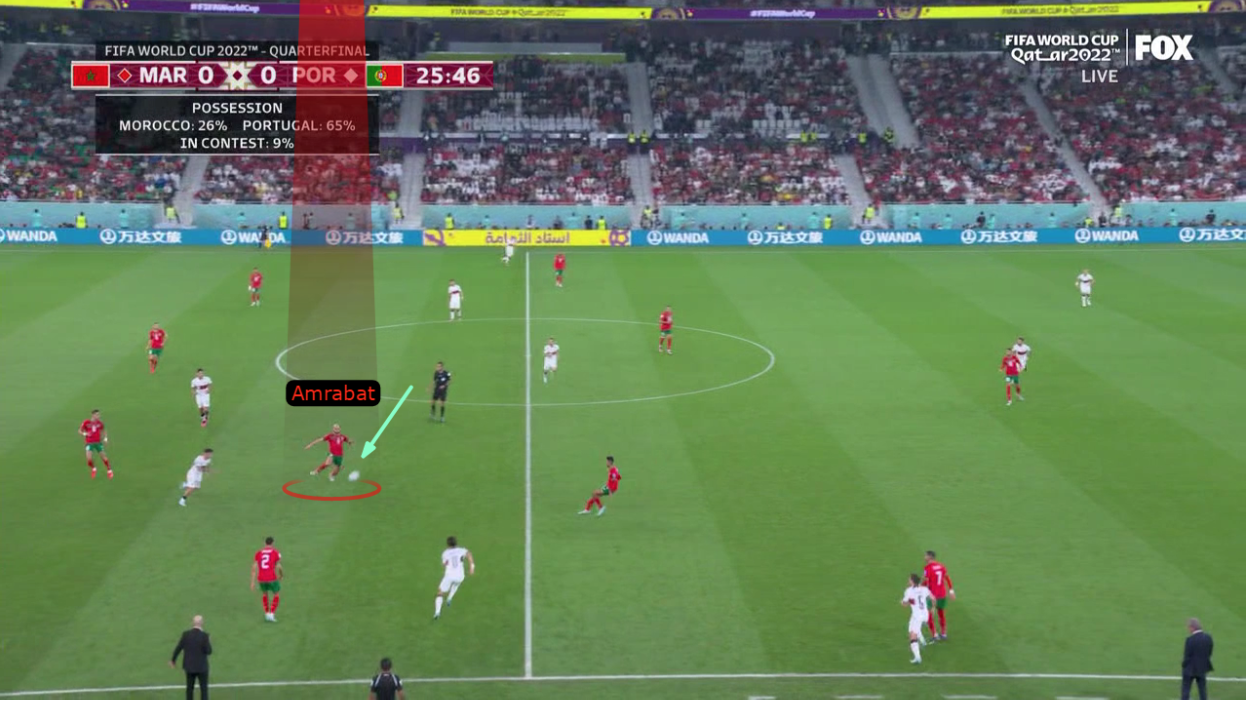
There was a clear problem with Portugal in the tactical positioning and the players’ roles with the ball, as the midfielders were in overlapping roles without understanding the role of each player, which caused problems in their positioning, as seen below.
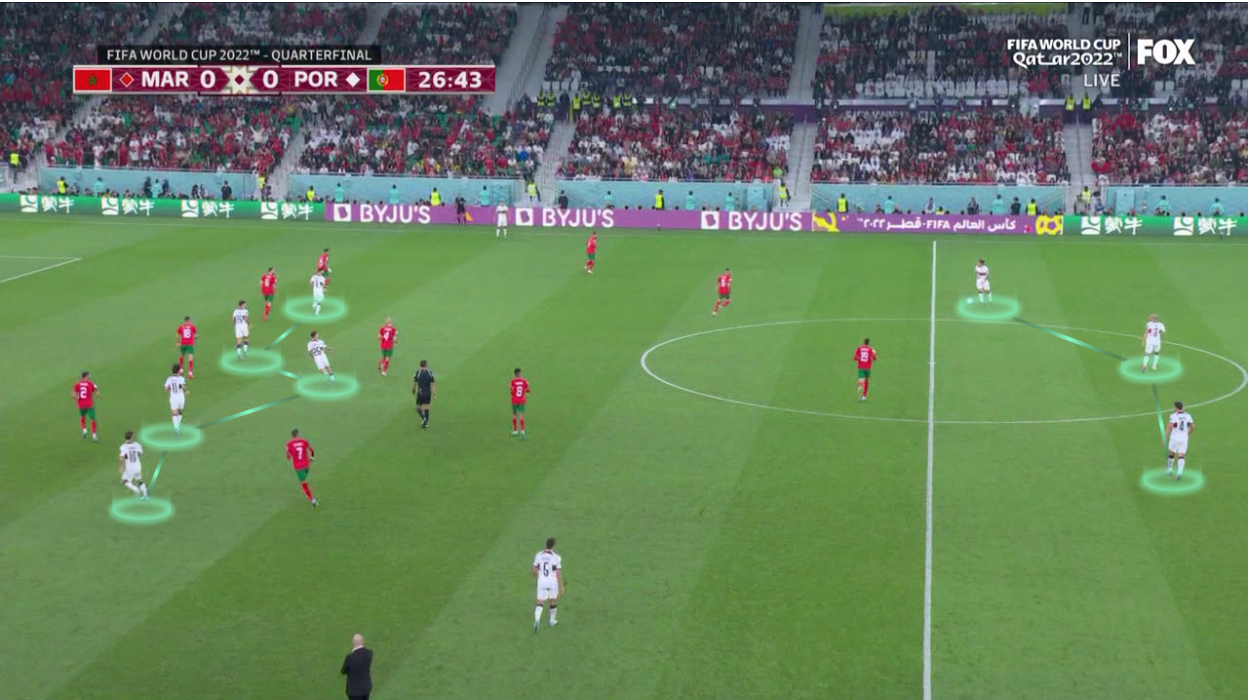
Morocco’s Low Block
In the second half, Morocco’s defensive block dropped back and was sometimes delayed, Portugal could not break this defense even with the entry of Cristiano Ronaldo, as the problems were clear in the process of linking players and positioning in the final third of Morocco, with the compactness of Morocco’s lines isolating the frontline from the ball.
Even if Portugal was able to break the block and reach it, the numerical superiority of the Moroccan defense would have cut off the ball, so the flank was the only solution. After the ball reached Ramos, Saïss came out to put pressure on him, and the other CB cut deep with the support of the defensive midfielder Amrabat.
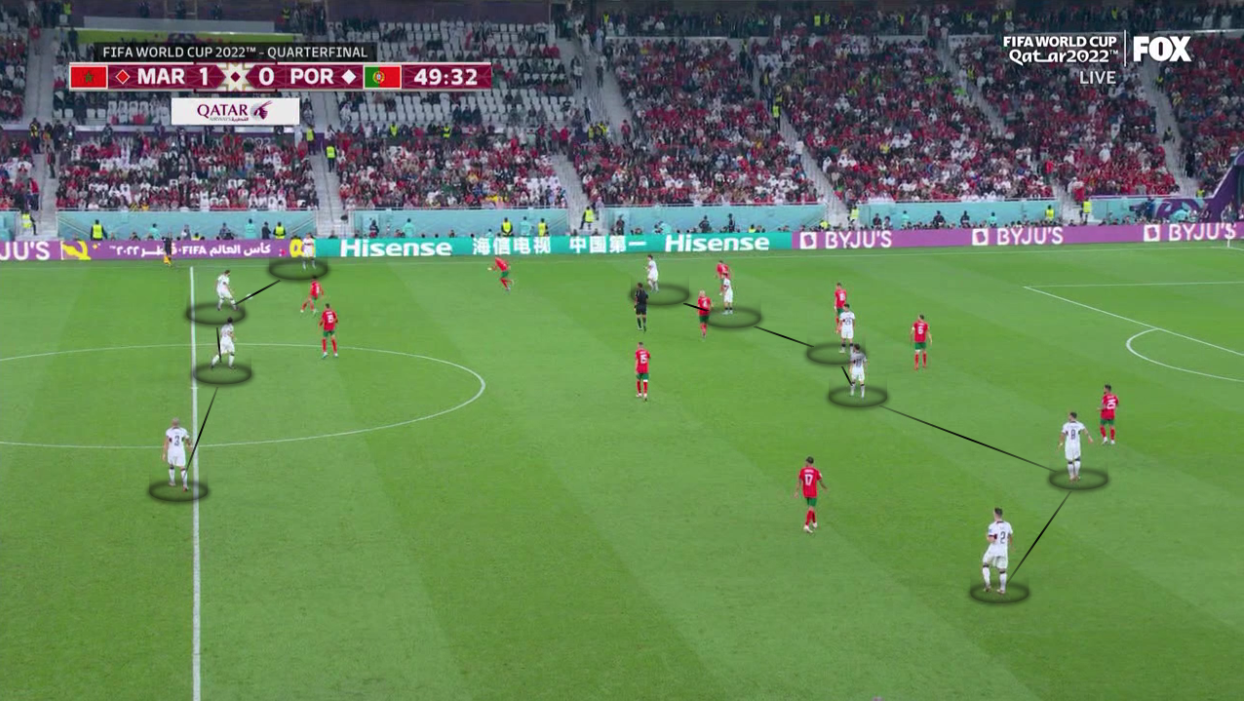
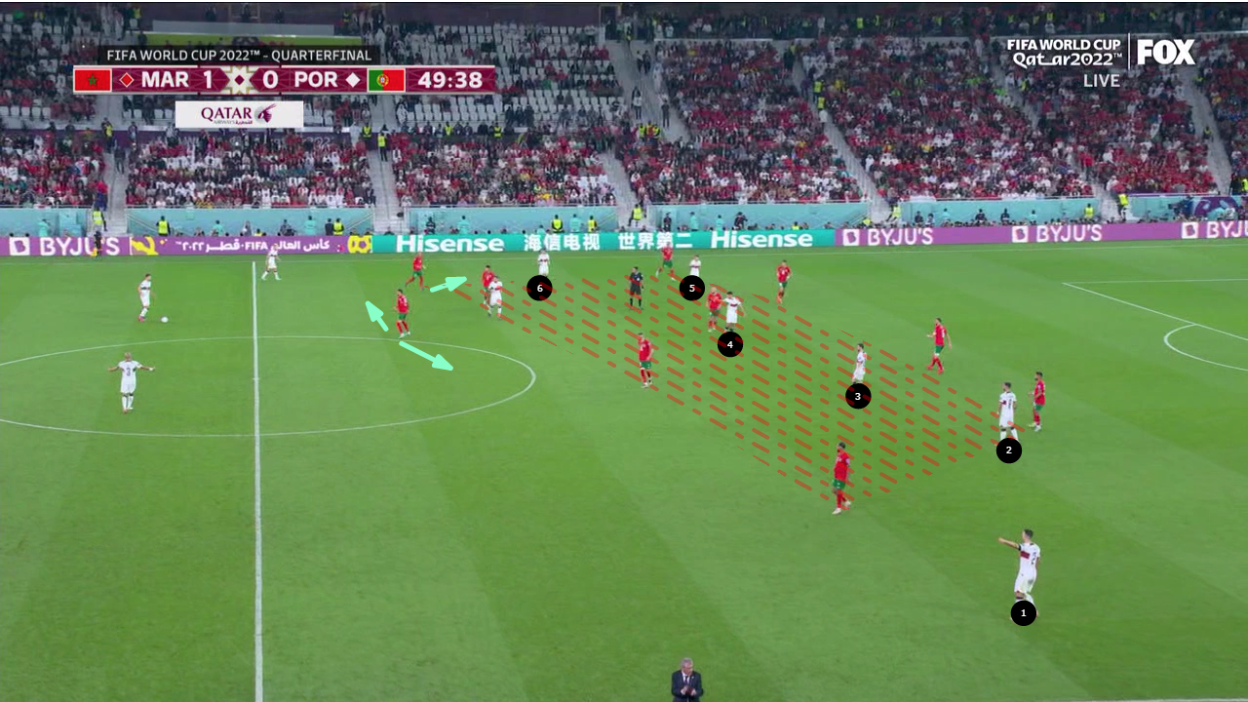
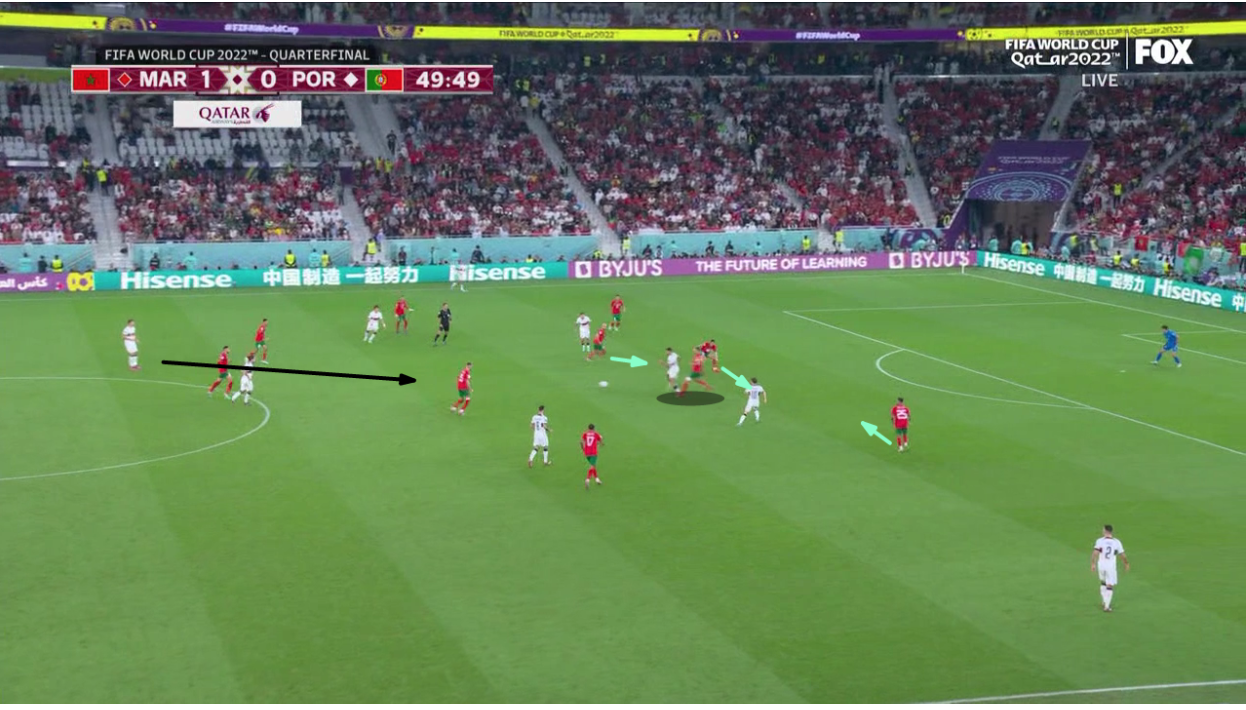
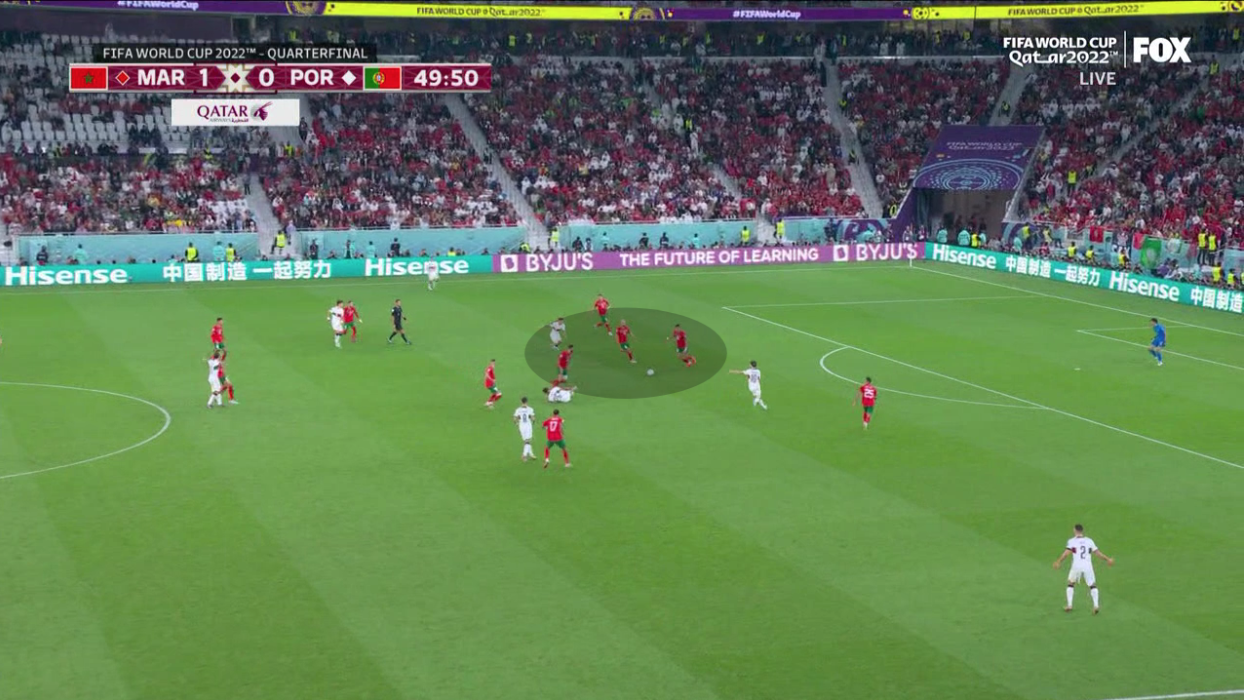
Six minutes after the restart, Santos subbed on Ronaldo for Ramos and João Cancelo for Guerreiro. With Ronaldo, the Moroccan CBs switched to mark him, which prevented them from going out as usual to meet the ball carrier, and here came the defensive role of Ounahi and Boufal in supporting them and returning to the back.
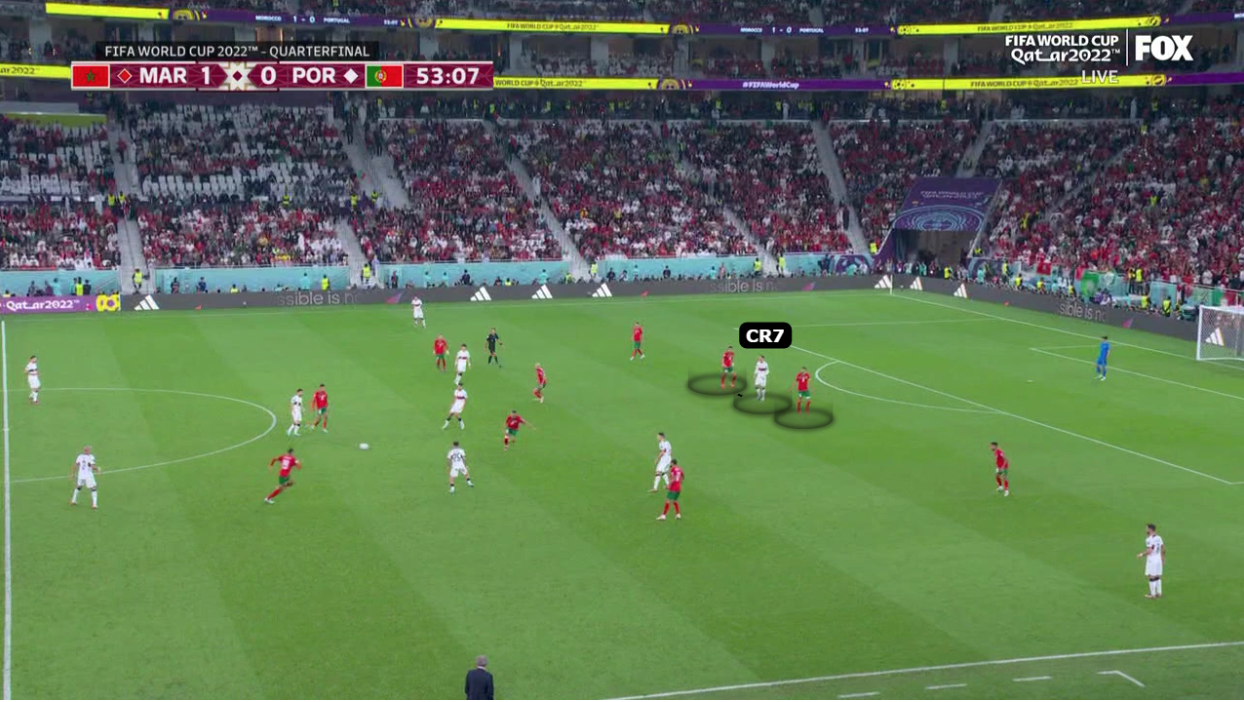
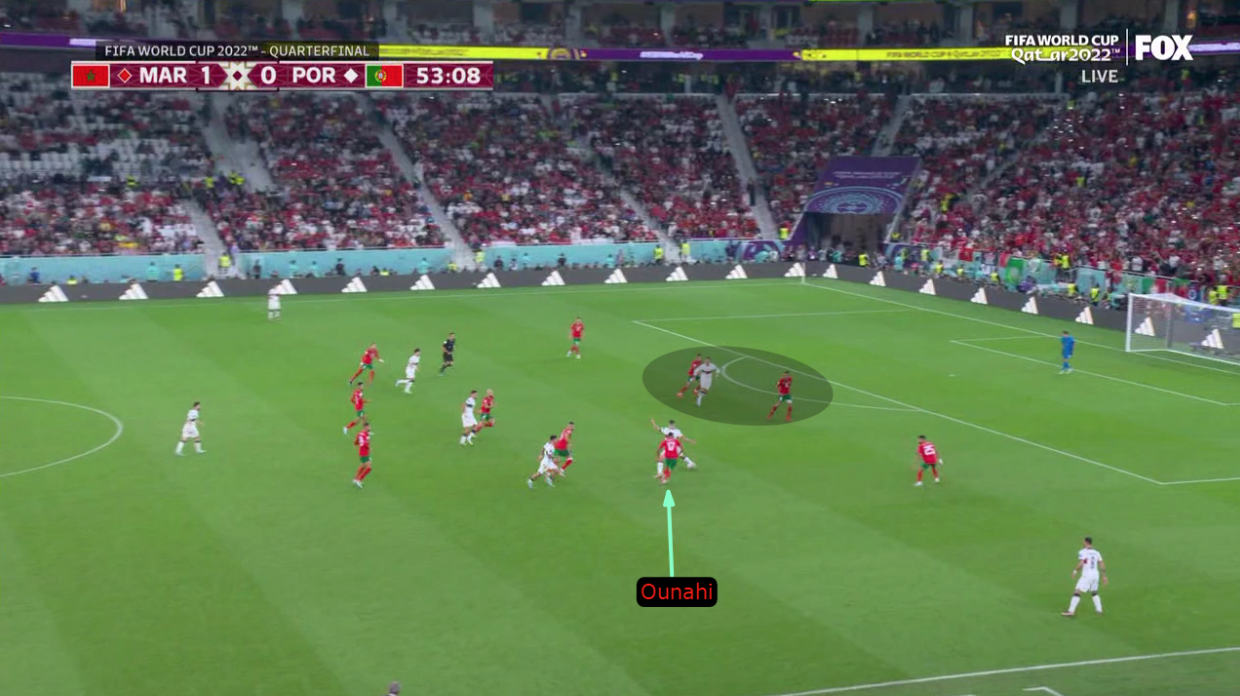
Six minutes after Santos’ double substitution, Achraf Dari came on for the injured Saïss, playing alongside Jawad El Yamiq, who was starting in place of the injured Aguerd. They would switch roles in order to control the threat of Ronaldo — when Ronaldo moved to the right, El Yamiq would press him. When Ronaldo moved to the left, Dari would now be tasked with dealing with the threat.
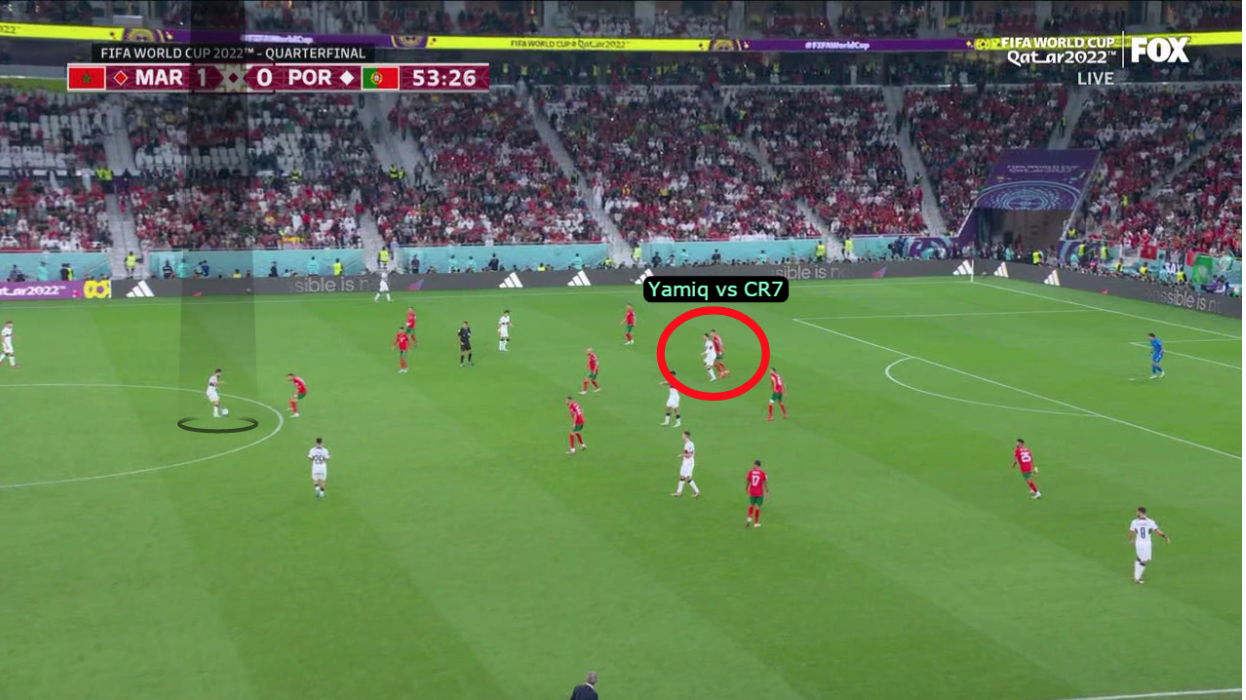
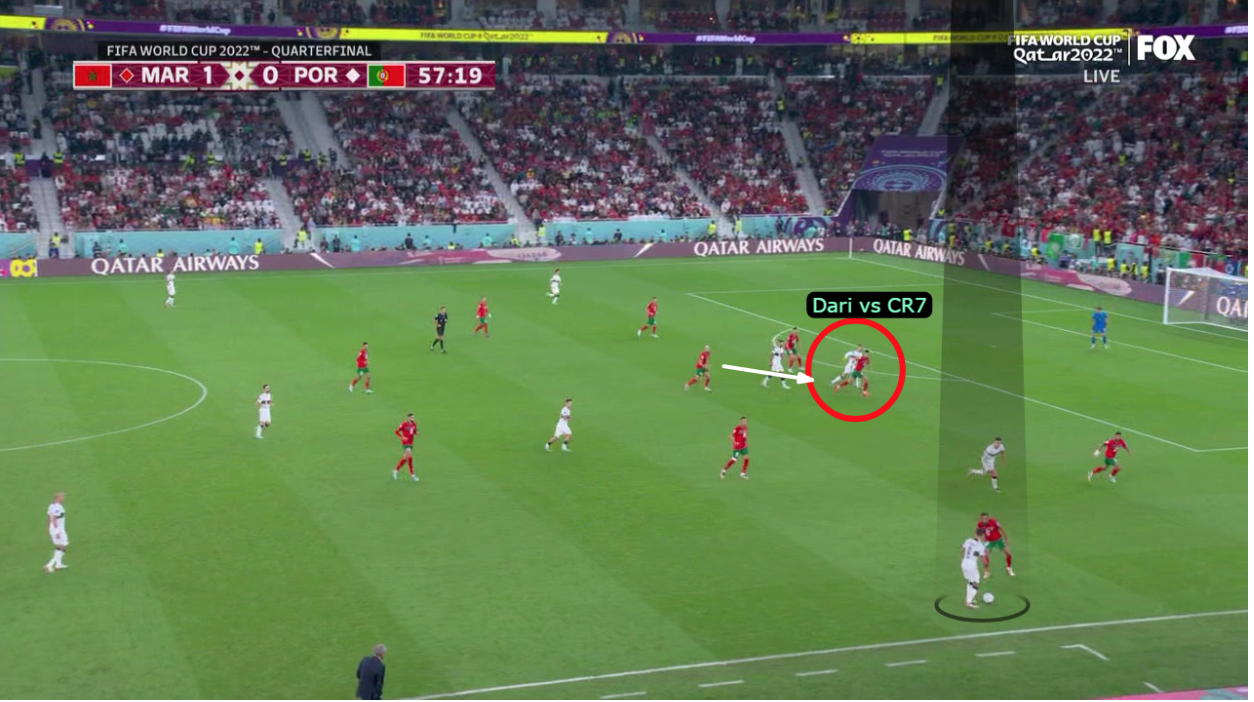
In a match that featured Rúben Neves, Bruno Fernandes, Otávio and Bernardo Silva, arguably the best midfielder on the pitch was Sofyan Amrabat. The Fiorentina man delivered a dominant display in the heart of the pitch and held his own to lead the Atlas Lions to the semifinals.
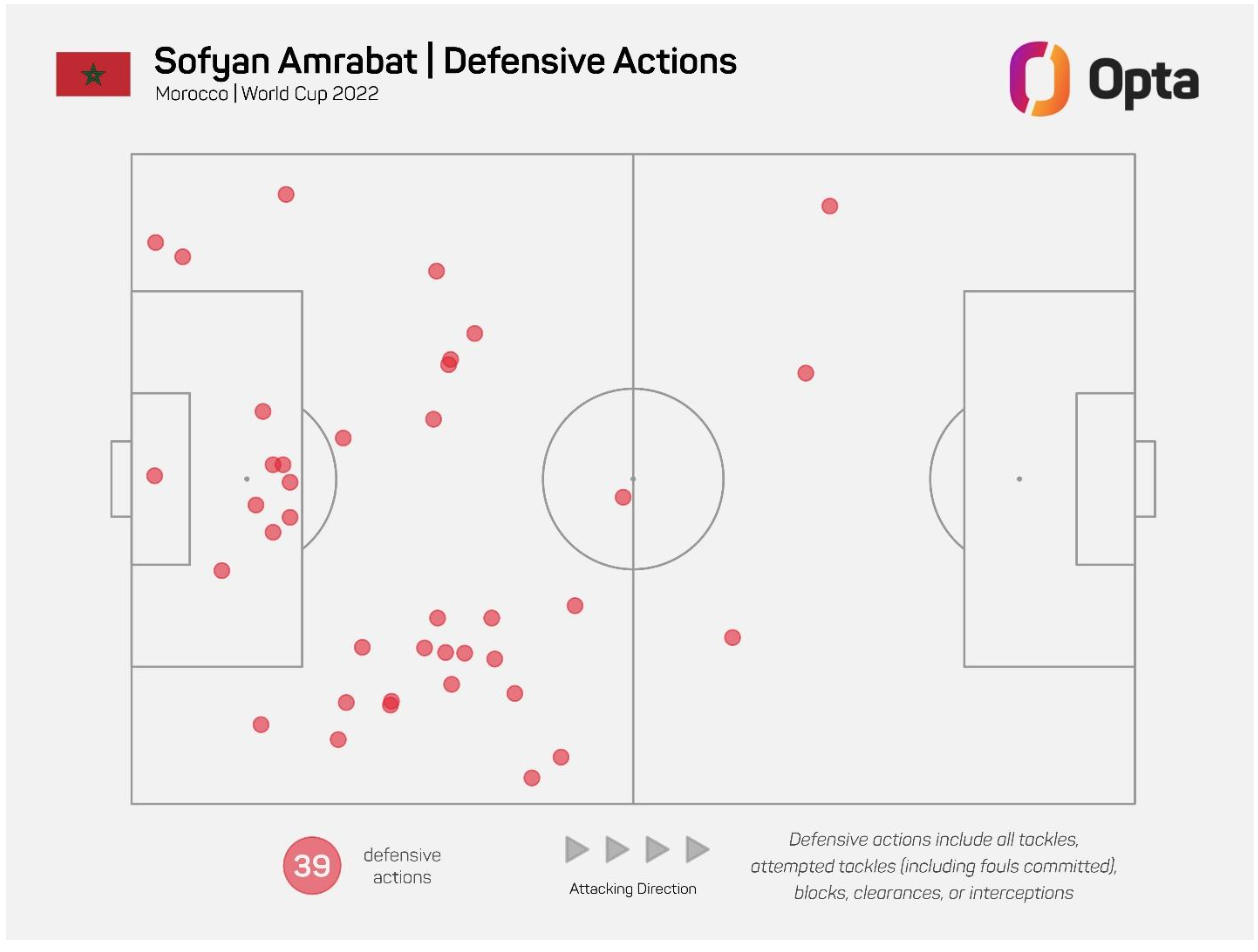
Whilst Morocco were unable to reach the World Cup Final, they have nevertheless written their names into the history books with a tournament that has seen them defeat Canada, Belgium, Spain and Portugal. Walid Regragui’s side have gone toe-to-toe with the best teams in world football, and they’ll be looking to follow their epic feat by ending a 48-year trophy drought and claiming their second AFCON title in January 2024.
By: Mohammad Bani Atta / @TacticalZone14
Featured Image: @GabFoligno / Visionhaus – Getty Images
